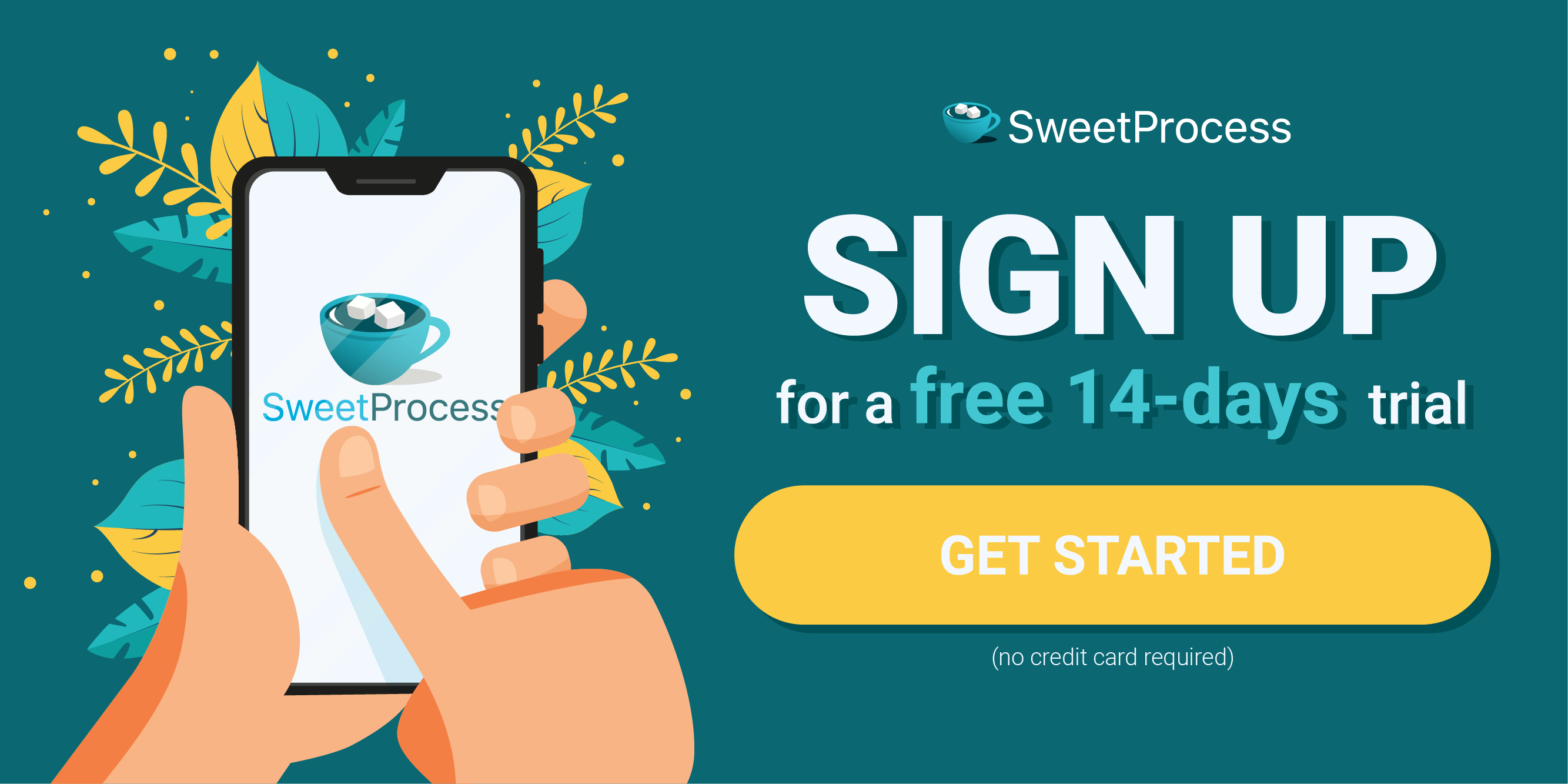Last Updated on February 7, 2025 by Owen McGab Enaohwo
![Employee Onboarding Process: How to Onboard New Hires Efficiently [+ Checklist]](http://www.sweetprocess.com/wp-content/uploads/2024/03/employee-onboarding.png)
You are excited about the prospects of your new employee with excellent track records, but unknown to you, they are already planning their exit. Why? They weren’t satisfied with your employee onboarding process. The circle continues, leading to a waste of resources as you invest in more hires.
An ineffective employee onboarding process costs you competent employees and breeds inefficiency in employees who stay as they lack the knowledge and skills for high performance.
SweetProcess is an employee training software for seamlessly onboarding new and established staff with standard operating procedures and policies. Sign up for a 14-day free trial without a credit card.
Table of Contents
Why Should You Onboard New Employees?
The Employee Onboarding Process: How to Onboard New Employees Into Your Organization
How to Streamline Your Company’s Employee Onboarding Process
How to Onboard New Employees Quickly and Easily Using SweetProcess
Stages of Employee Onboarding: How to Integrate New Hires Into Your Organization
Benefits of an Effective Employee Onboarding Process
Employee Onboarding Best Practices You Should Follow
Employee Onboarding Checklist: The Single Tool You Need for a Successful Onboarding
Employee Onboarding Examples You Can Learn From
Onboard New Employees Seamlessly Using SweetProcess
What Is Employee Onboarding?

Coming into unfamiliar territory can be uncomfortable. Whether you are moving to a new place, starting a new job, or meeting new people, settling in the environment and getting the hang of things is challenging. It’s easier if you have someone to show you around. This is the primary aim of employee onboarding in the workplace.
New employee onboarding is the process of acquainting new hires with an organization’s policies, culture, and the roles they will perform. It’s a crucial activity that determines how resourceful employees become—the better the onboarding process, the higher their knowledge about the company and their responsibilities.
Employee onboarding is an opportunity for a business to introduce itself to new workers—beginning from the moment an employee accepts an employment offer. How the company communicates with them onward influences their perception and attitude toward work. Familiarizing employees with company policies and training them on their duties are integral to onboarding. They must understand the compliance requirements in the best interest of the organization and be diligent in their tasks to meet those requirements. However, how they fare in these areas largely depends on their onboarding experience.
Employee onboarding is an avenue for highly skilled employees with many options to know if an organization is the right fit for them. They want to work in a place where they can thrive—with opportunities for career growth. The business environment, company culture, and availability of work resources are some factors they evaluate in the onboarding process before deciding whether to stay. Organizations lose competent workers as a result of having a poor onboarding process.
Employee onboarding isn’t exclusive to new hires. Established workers take up new roles and responsibilities in their jobs; they need to be acquainted with the positions and environments to deliver great results. The inability to effectively onboard a high-performing staff into a new role could make them less productive. Effective employee onboarding at all levels lays a strong foundation for staff to be efficient in their jobs and positively impact their organizations.
The success or failure of the employee onboarding process can be determined by the people who engage with employees in the process. Since they represent the organization, their actions are viewed as the company’s actions. If an onboarding manager is impolite or arrogant, they create an impression that the work environment is toxic, which could scare away some employees. It’s important to have the right human and technical resources in the employee onboarding process.
The duration of new hire onboarding isn’t one-size-fits-all, as every organization is unique. However, it’s recommended that the process should last for at least three months and not more than one year.
Why Should You Onboard New Employees?

A Brandon Hall Group research revealed that a great onboarding experience increases employee retention by 82%, and the productivity of these staff increases by more than 70%. This shows the impact of employee onboarding on organizations. Let’s take a look at other benefits involved.
Familiarize With Company Culture
Company culture encompasses its vision, mission, and core values. An organization can achieve its objectives and goals better when team members work collectively. New employees may not understand its culture no matter how popular an organization may be. Employee onboarding enables management to educate employees on what drives the company. This creates a sense of belonging and responsibility in staff as they understand the reason for working and can see the big picture.
Train on the Job
Having the skills to execute designated tasks successfully differentiates competent employees from their counterparts. Those skills don’t emerge by chance but through training and other deliberate efforts to be efficient. Organizations are in a position to set the ball rolling by training them on how to perform their jobs. This is a case of garbage in, garbage out. If you train your team members well during onboarding, they’ll most likely perform their tasks effectively.
Comply With Regulatory Standards
Complying with regulatory standards is mandatory so that you don’t suffer severe consequences. Non-compliance often results from inadequate information and skills among workers as they make costly mistakes. Employee onboarding is an avenue for compliance education. When new hires understand acceptable and unacceptable codes of conduct from the start, they behave accordingly. They may not be able to perform all tasks within a short time, but they can identify non-compliant activities and steer clear of them.
Reduce Employee Turnover
When a competent employee quits their job, the organization loses the value the person offers and spends money and other resources to replace them. The exit creates a productivity gap that current employees must fill, impacting the company’s overall output as some areas will suffer. All this can be avoided with an effective onboarding process that increases retention. Fewer employees will leave because they enjoy their jobs.
Cultivate Teamwork and Mentorship
Healthy relationships in the workplace help employees thrive in their jobs. New staff members may not know anyone in the organization, and this could make them feel isolated. The onboarding process allows them to meet other staff members, including fellow new employees and established ones who facilitate the onboarding process. If the environment is conducive, participants feel free to engage freely and create meaningful relationships that will positively impact their work.
The Employee Onboarding Process: How to Onboard New Employees Into Your Organization

New employees are most likely excited about starting work at your organization but that can be short-lived if the onboarding process doesn’t meet their expectations. Only 12% of employees are satisfied with the onboarding program they received in their organization. Considering the following factors produces mutually beneficial outcomes for you and the staff.
Prepare a Detailed Description of the Role
Jobs are advertised with their roles and descriptions. An employee who made it to the onboarding stage should know the role and descriptions of their job. Notwithstanding, you should prepare a document with detailed descriptions of their responsibilities to erase any confusion and give the new staff a clear direction. Describing employees’ responsibilities in detail helps clarify similar duties and state tasks that were omitted initially.
Provide Information on the Company’s Policies and Benefits
There’s no better time to educate new employees about company policies than immediately after they join the company to guide them on the code of conduct. This is key as they could do things that contradict company policies. If no physical contact with customers is a company policy, a new employee could ignorantly make contact with a customer if they are unaware of the policy. Business policies should be one of the first items in the onboarding process to avoid non-compliance issues.
Employment benefits excite employees and motivate them to work harder. The onboarding process is an opportunity to reiterate the perks of working at an organization, including salaries, bonuses, and vacations, as they may not understand those employee benefits in detail.
Plan a Progressive Training Schedule
Employee onboarding is most productive when you treat it as a continuous process, not a one-off activity. There’s so much to train new staff on, and trying to do it all quickly isn’t practical—you might overwhelm them with too much information and exhaust yourself too. Outline the training subjects sequentially with the most important ones in the front. What information do they need to know the most? Start with those and move on to others gradually.
Induct Into Organizational Culture
Organizational culture embodies the values and practices employees are to uphold in their interactions and engagements in the workplace, and it differs in organizations. Educating new staff about your organizational culture guides them on the values to prioritize as they interact with team members, customers, and members of the public. It also helps them inculcate humanness into their jobs instead of treating it as a chore.
Establish Performance Metrics
The end game of the onboarding process is to empower employees to be efficient and productive. How do you arrive at these conclusions? Adopting a standard framework to establish your performance metrics solidifies your results. A good example is the management by objectives (MBO) model, which allows you to measure employees’ performances according to their ability to accomplish established objectives. You assign a numerical value to each level of the task and grade team members based on their level of completion.
Integrate New Employees With Other Team Members
Cultivating healthy relationships at work enhances employee performance. The onboarding process is a great opportunity for organizations to introduce new employees to their established colleagues. Line managers are some of the first people new staff members engage with as they guide them through onboarding. Widen the net by creating avenues for new hires to engage with other staff members too. You can ask skilled team members to assist them with some activities during onboarding.
Present Information in Different Formats
The employee onboarding process can easily become boring and tiring as there’s so much information for a new hire to grasp. They won’t understand most of the training once exhausted, which defeats the onboarding goal. Make it more interesting by presenting information in different formats. You can achieve this by documenting your policies and processes in multiple formats, including video, audio, and diagrams. Give them quizzes to perform in between tasks to get them excited.
Perform Regular Follow-Ups
Employee onboarding in many organizations has a honeymoon phase. New employees get maximum attention in the beginning, and they are abandoned shortly after. Leaving new hires to navigate the organization independently before they become confident in their tasks will make them feel neglected and question if your organization is the right fit. Check in with them regularly to know how they are faring. Ask them questions about areas they are struggling with and offer guidance accordingly.
Re-Onboard When Necessary
Use established metrics to evaluate employee performance. If their performance isn’t satisfactory, consider re-onboarding them. Identify areas they struggle with from your evaluation and pay more attention to them as you repeat the onboarding. There may be a need to re-onboard employees when there are major changes in your operations to acquaint them with the latest developments.
How to Streamline Your Company’s Employee Onboarding Process
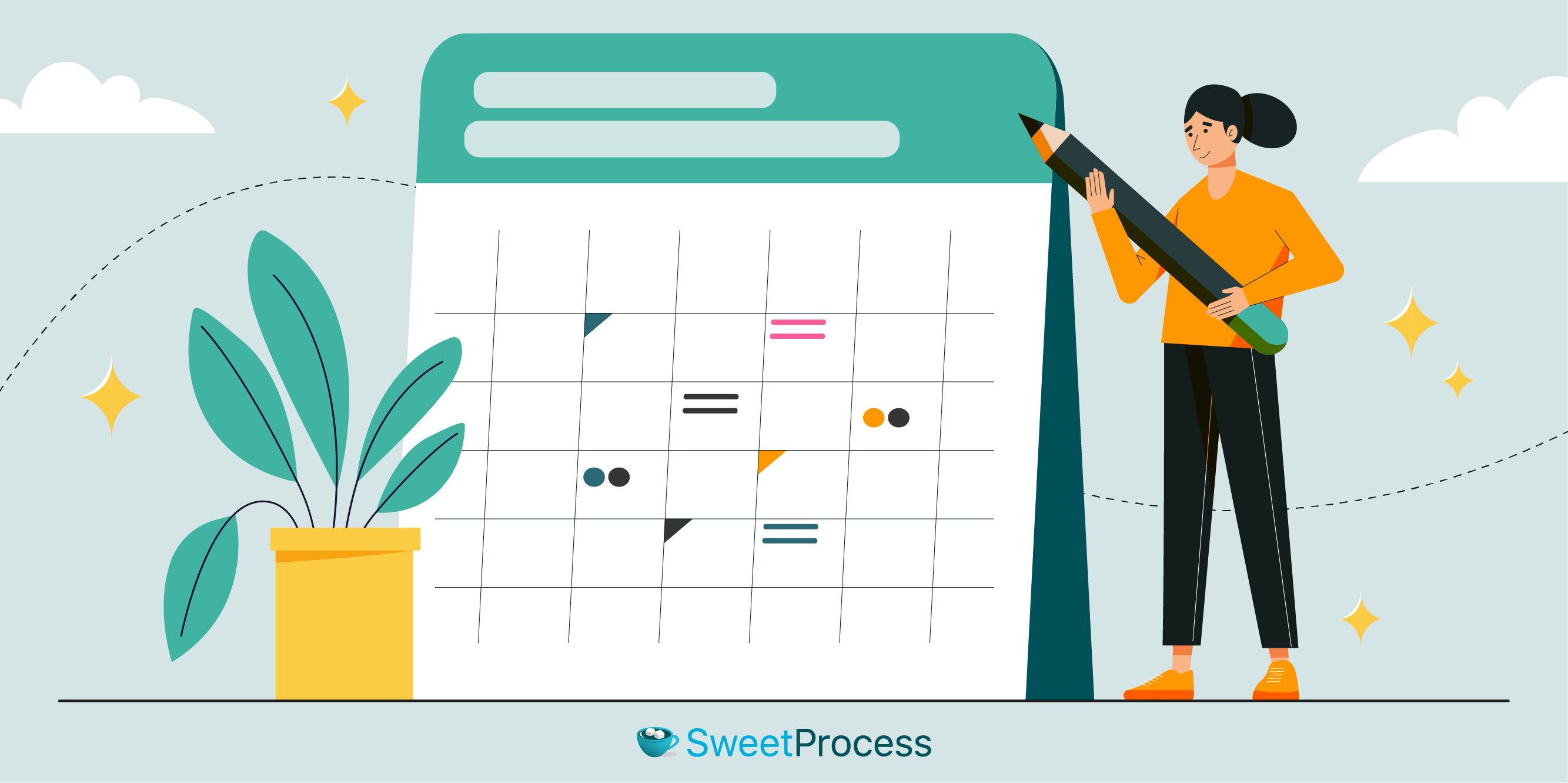
Digital technology has raised the bar in employing onboarding. New and established workers expect organizations to leverage technology to streamline the onboarding process for a seamless and positive onboarding experience. Failure to do this raises questions about an organization being a good fit for them. Here’s how to streamline your company’s employee onboarding process for maximum results.
Create a Standardized Onboarding Checklist
The first step to streamlining employee onboarding is to outline the activities for the process. Employees may be assigned to specific departments, but it’s important to acquaint them with information and skills about core aspects of the organization. Developing a standardized checklist ensures that employees are privy to the same information and training regardless of their location or period of joining the company.
Key components of a standardized onboarding checklist include the following:
- Company culture
- Mandatory compliance training
- Policies, processes, and procedures
- Technical skills development
- Soft skills development
- Technology tools and systems
- Products and services
Digitize Onboarding Documents
Using paper-based documents for most of your onboarding activities creates an impression that your organization hasn’t joined the digital train, and that could make forward-thinking employees question if they are in the right place.
Digitizing onboarding documents makes it easier for team members to access documents easily, especially when they need to do so remotely. This entails adopting effective software for creating policies, processes, procedures, and other documents. The right tools offer ready-made templates and artificial intelligence tools to create content from scratch so you don’t have to sweat over creating the documents.
Provide Tools and Resources
Employees need certain tools to participate actively in a digital onboarding process. This includes devices, apps, and user accounts to access designated apps and documents. Running around during onboarding to set up these tools doesn’t look good on your organization. Make provisions for the items ahead of time and confirm that they are operable. Envisage unforeseen circumstances that could get in the way, such as devices becoming faulty at the last minute, and position measures to resolve them.
Centralize Information
Centralizing information is about creating and storing all onboarding materials in a single system accessible to team members. Sending information separately to team members via email, for instance, isn’t very efficient—it’s time-consuming with chances of omissions and mixups. Making all information available in a knowledge base and granting authorized access to users speeds up the onboarding process, as they can access documents independently at any time. New information can be documented and made available to participants immediately, as they can all access the system.
Automate Repetitive Tasks
There are many activities on a typical onboarding checklist—leveraging digital technology to execute repetitive tasks reduces the workload and increases performance. Manually granting participants access to apps and documents is time-consuming; therefore, you can use a digital system to automate the task. You can also automate sign-offs so team members can indicate that they have read certain documents or performed certain tasks without manual prompts.
Track Training Progress
Part of the onboarding process is to confirm that employees engage with the materials you provide them. Doing this manually can be tiring on your part and overbearing for employees. Your best bet is to implement a workflow management system that tracks participants’ engagements with ongoing tasks in real-time. It shows you who has engaged with a task and their input to it.
Onboarding isn’t a formality; employees must grasp the information and skills they are taught. Tracking their activities shows how they are learning and engaging with tasks.
Continuous Improvement
Today’s information and skills may become obsolete tomorrow. This is why growth-focused organizations conduct regular training for new and established employees. Keep an eye on your team’s performance and what is happening in your industry to ensure that both are in sync. Inculcate new developments in your onboarding process for incoming employees and re-onboard team members if needed.
Collect feedback from participants about your onboarding process to identify areas of continuous improvement. You can use anonymous surveys to get team members’ honest feedback.
How to Onboard New Employees Quickly and Easily Using SweetProcess
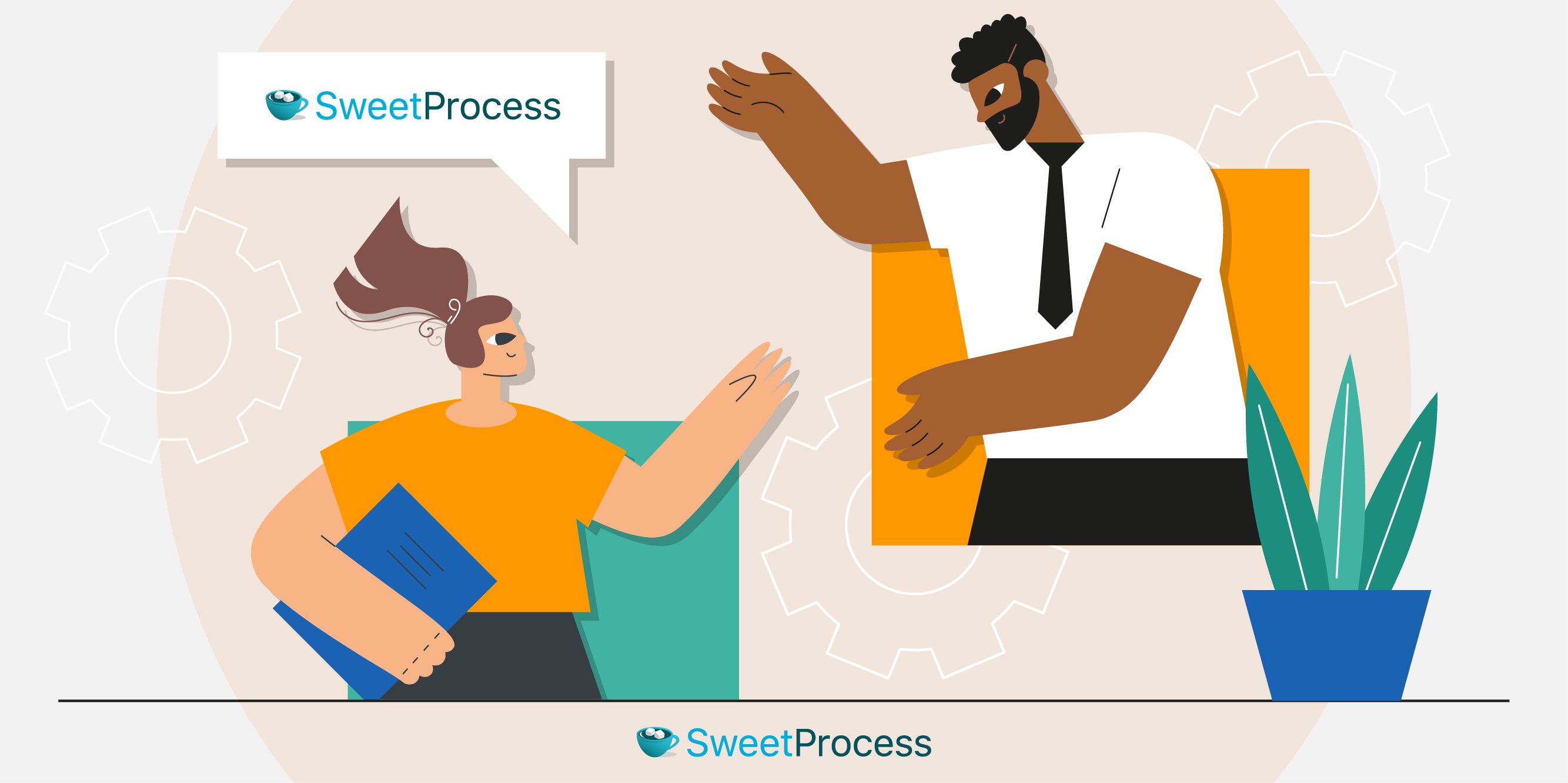
SweetProcess is an employee onboarding tool that provides employees with business policies, procedures, and processes to perform daily tasks. It offers automated tools for streamlining tedious and repetitive tasks, giving workers opportunities to be more efficient and productive.
SweetProcess simplifies the documentation of various work-related information and makes it available to remote employees and team members in a decentralized system, removing geographical barriers. This is key in today’s society, where remote onboarding is popular.
You can also take care of remote offboarding with proper documentation. This is why you need an offboarding checklist to prepare for exiting employees.
How to Document Policies in SweetProcess

There are two ways to document policies in SweetProcess: manually and automatically. If you don’t feel up to creating a policy from scratch, you can use its artificial intelligence content creation system, SweetAI, to create the policy. You can also edit your existing policies with AI.
How to Create a Policy Manually in SweetProcess
Click on “More.”
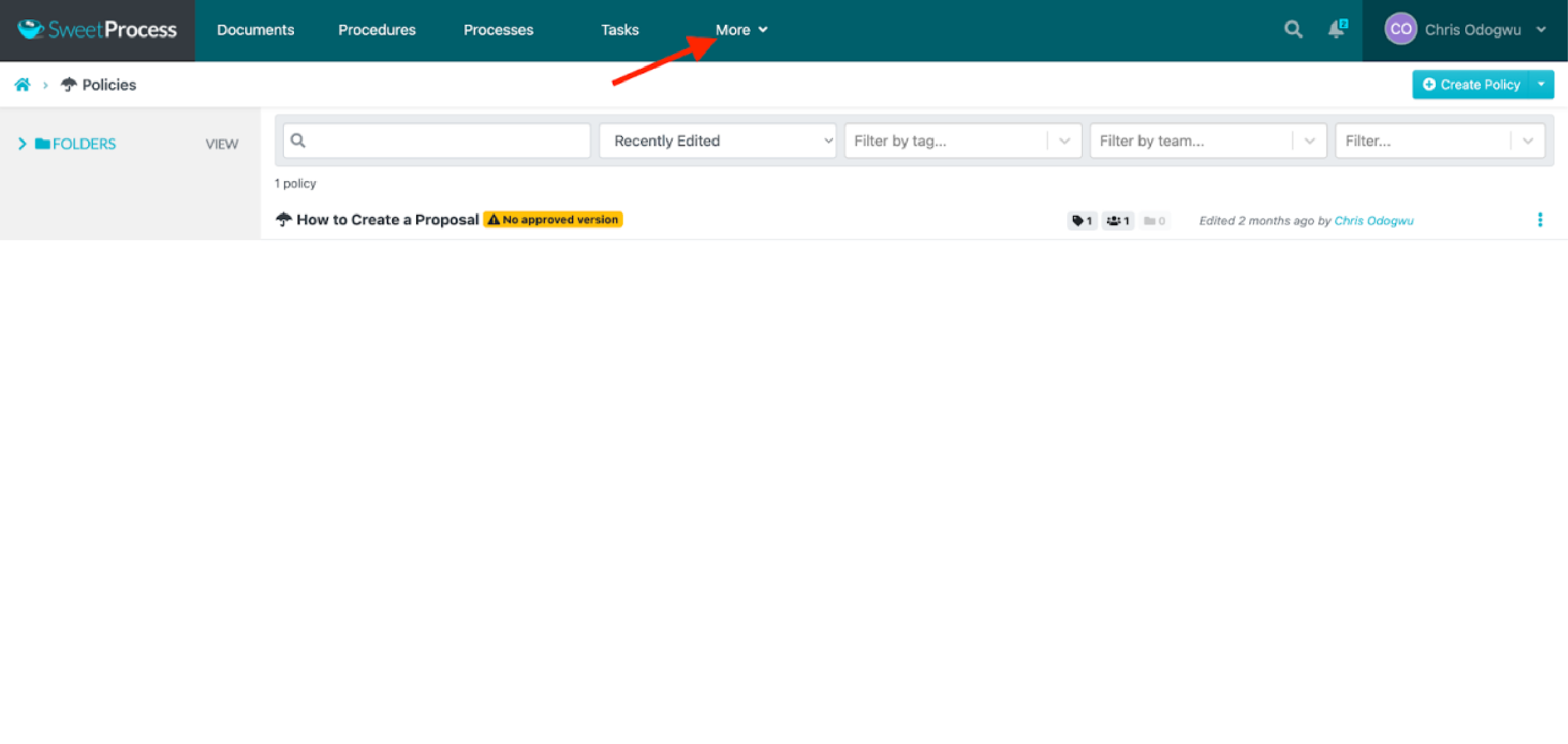
Select “Policies.”
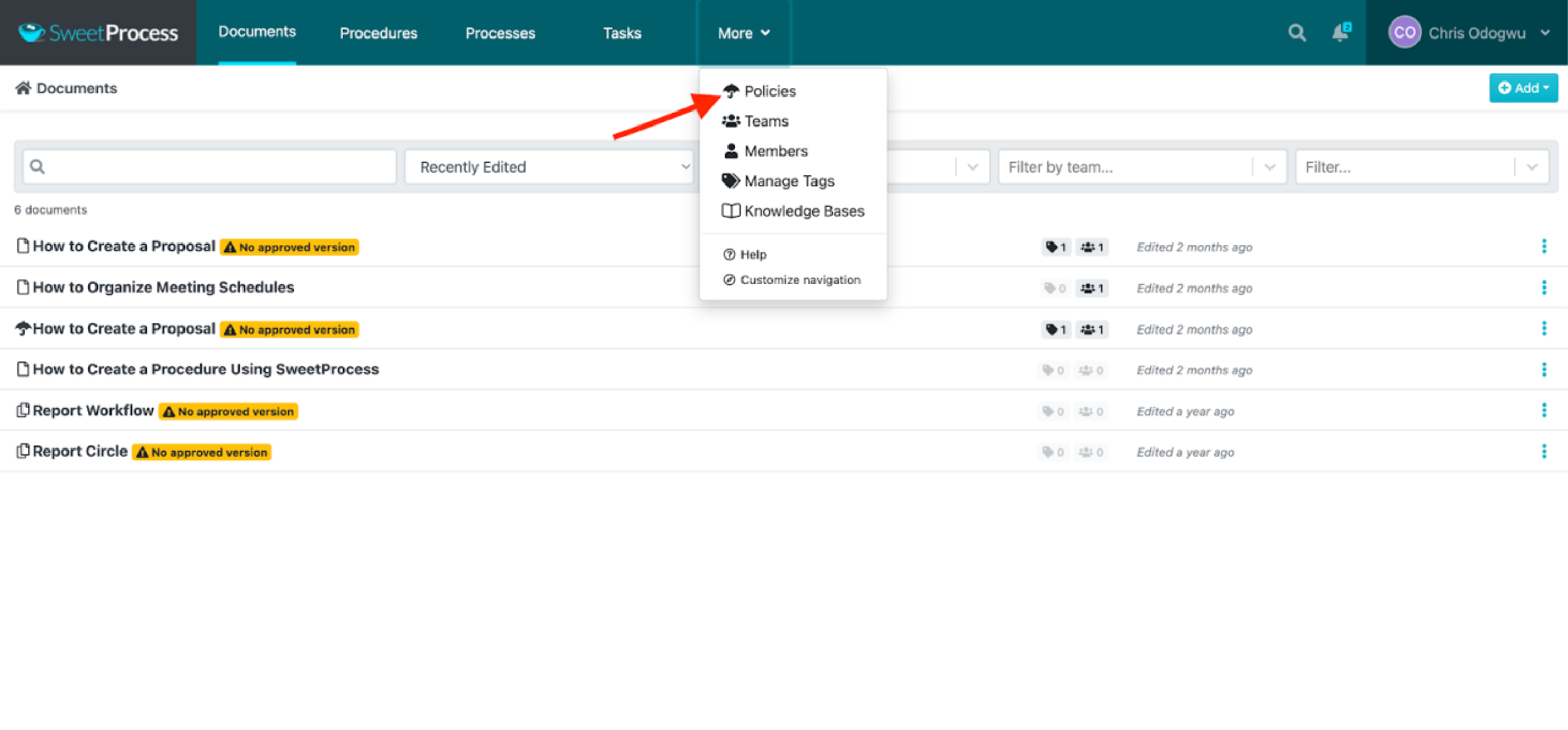
Click on “Create Policy.”
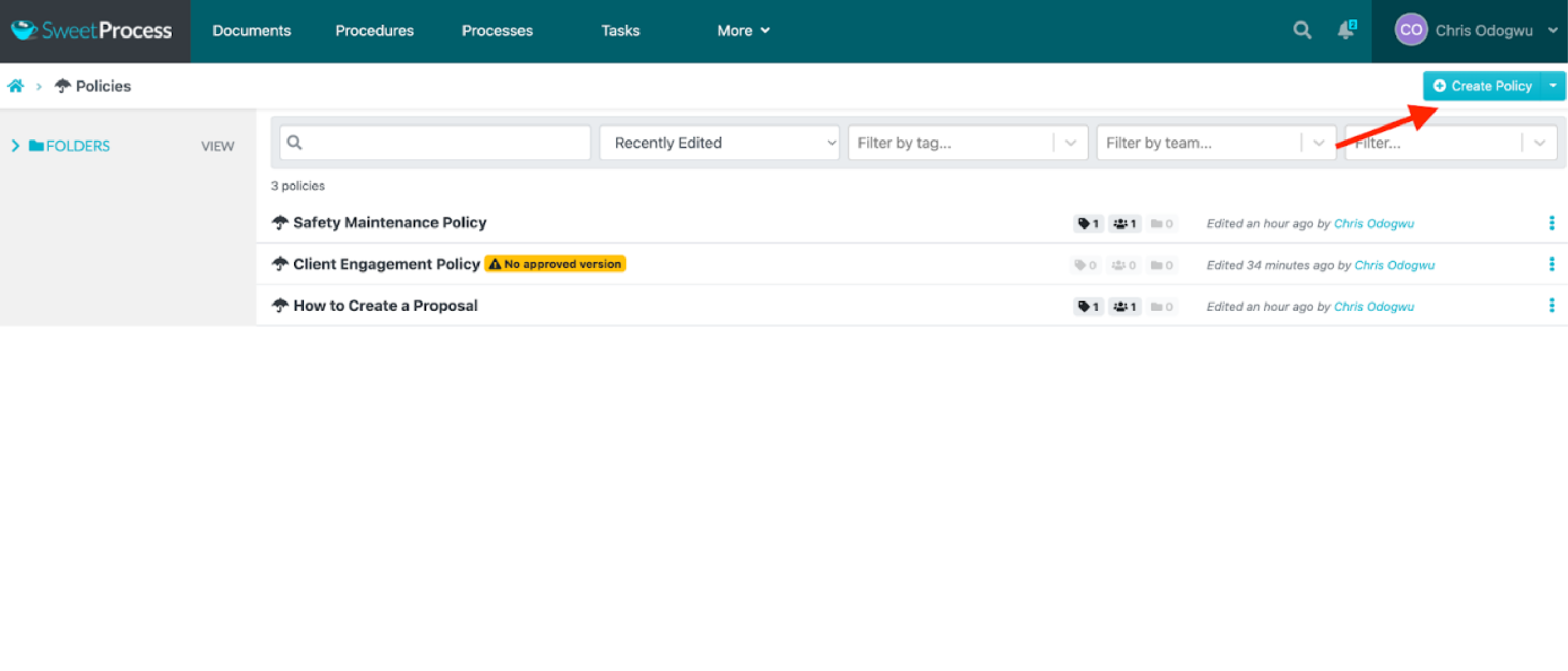
Enter the policy title and click on “Continue.”
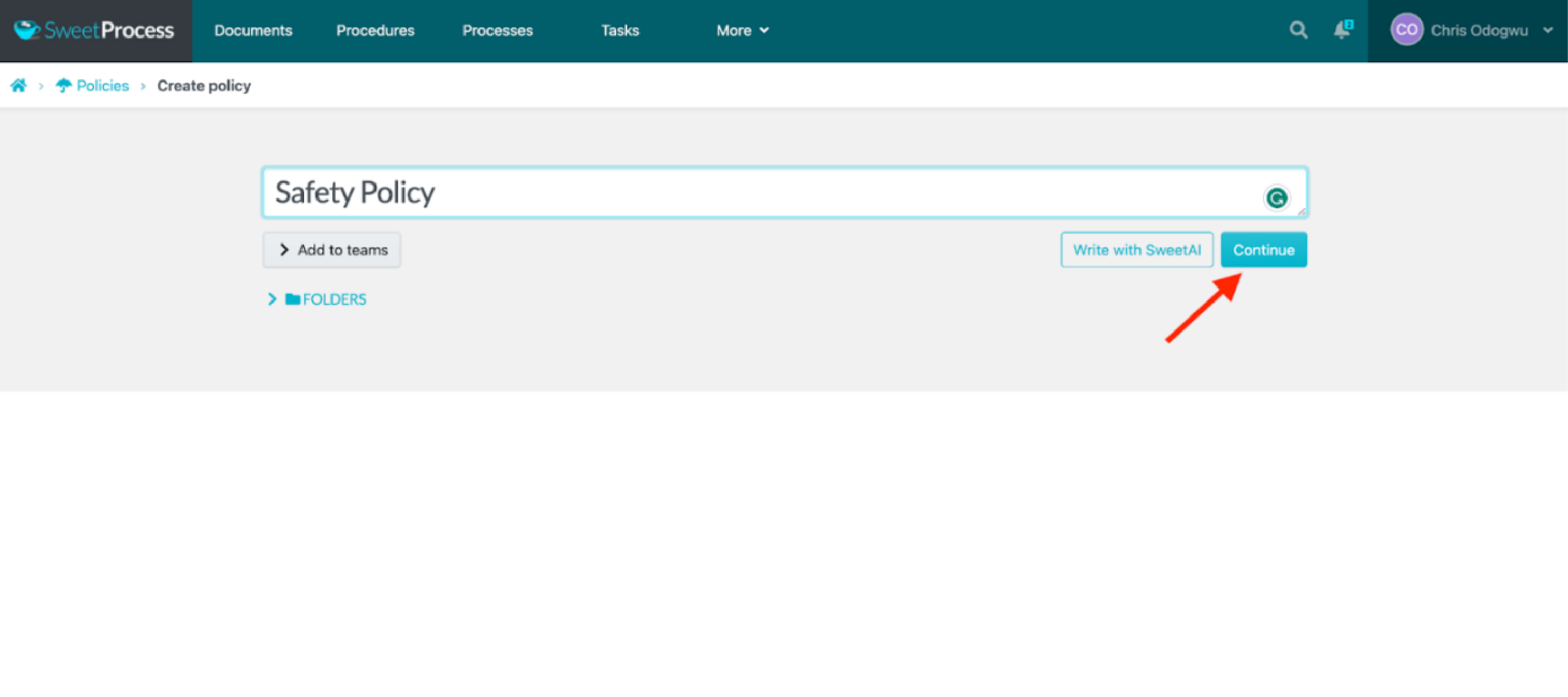
Click on the pencil icon to edit your policy.
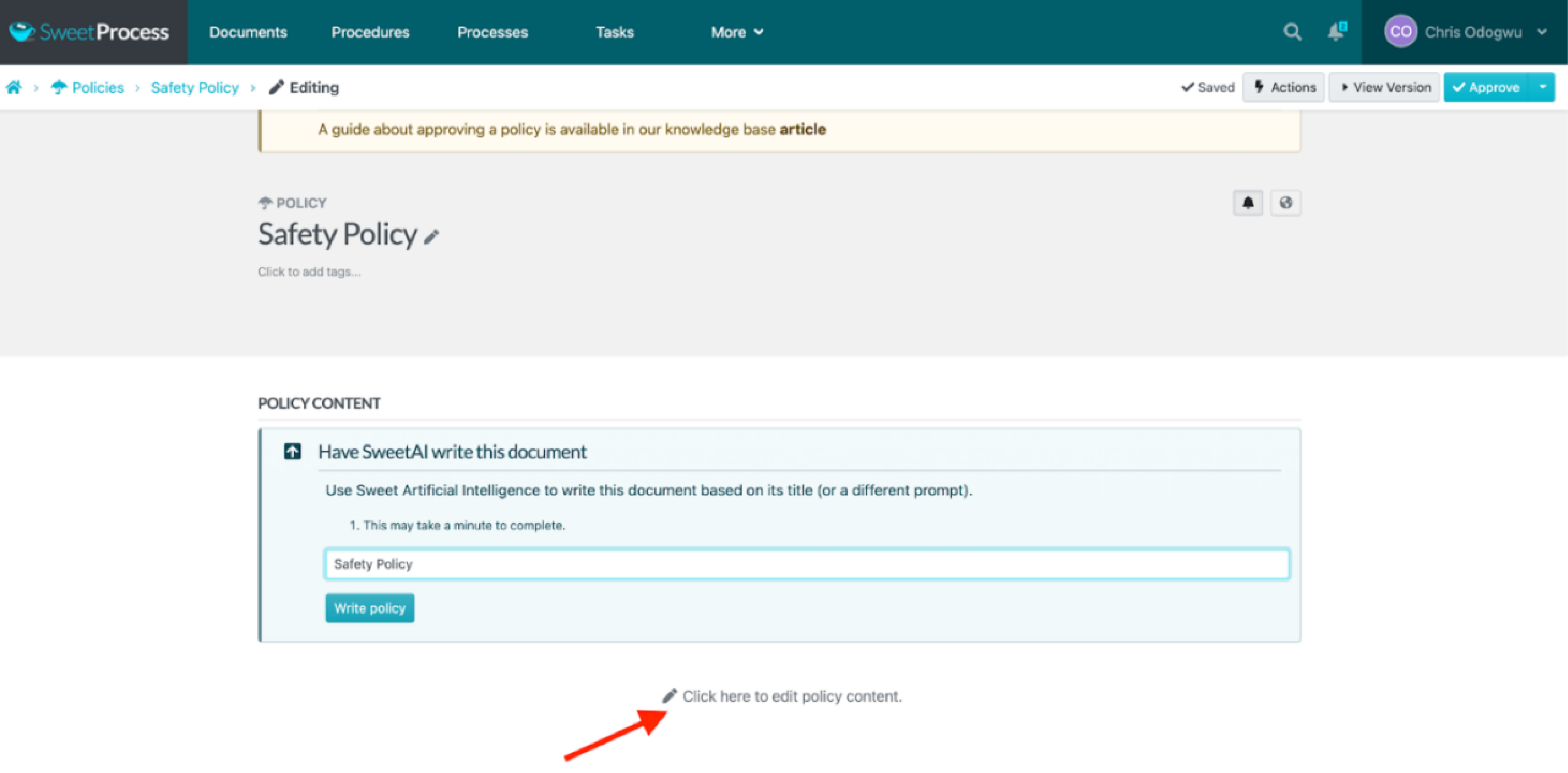
Click on “Save changes” after editing.
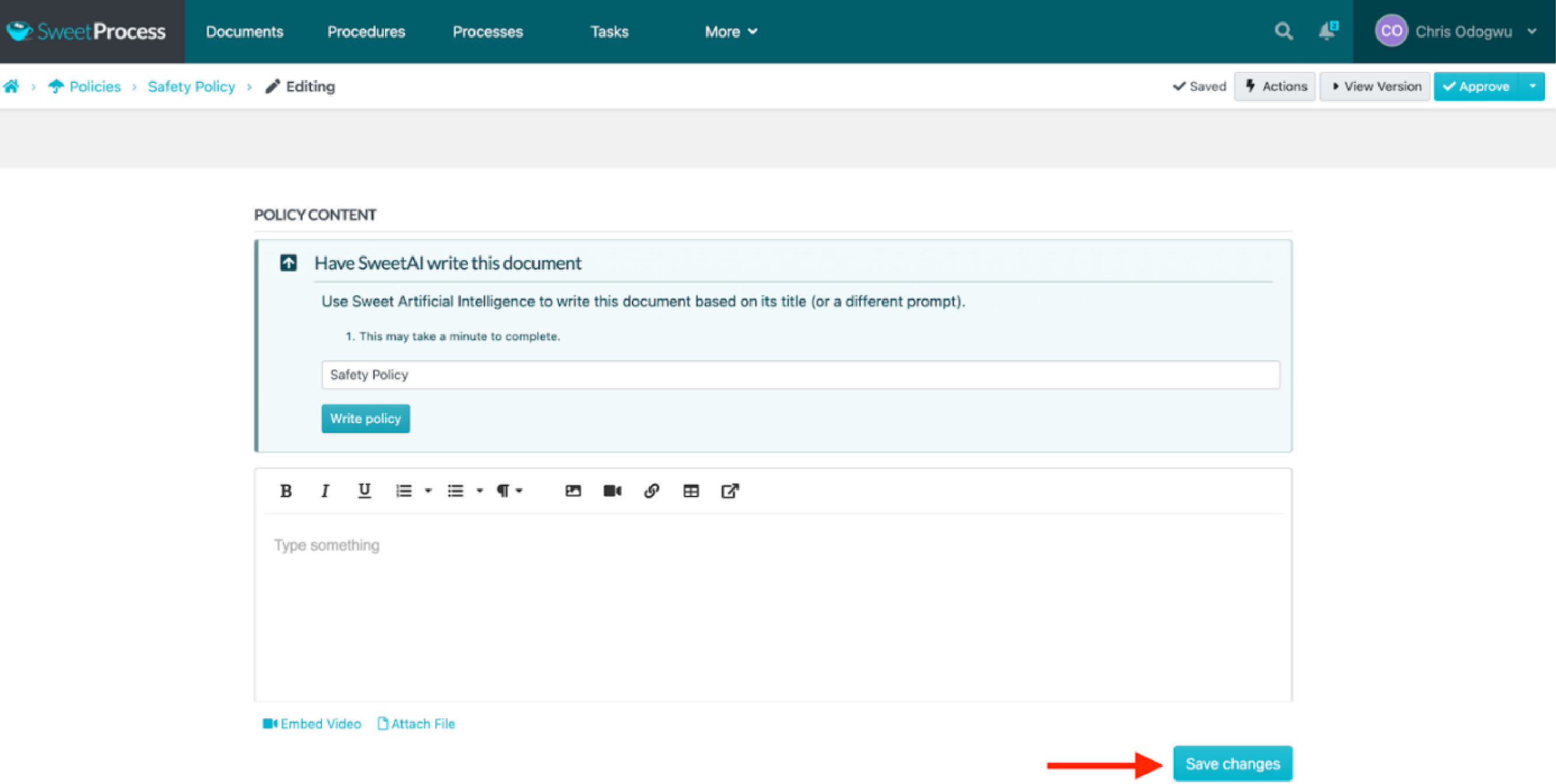
How to Create a Policy Automatically in SweetProcess With Artificial Intelligence (SweetAI)
Click on “More.”
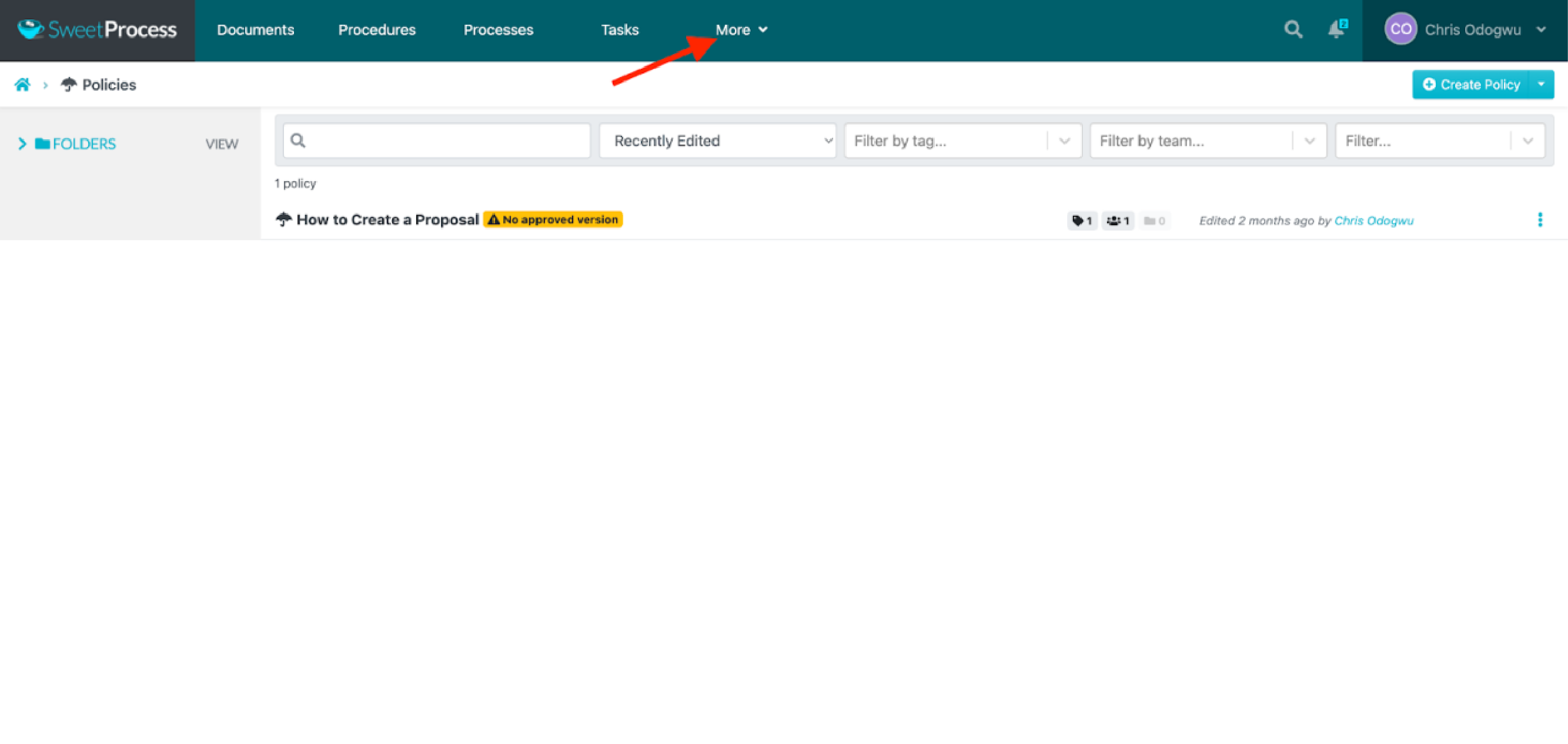
Select “Policies” and click on “Create Policy.”
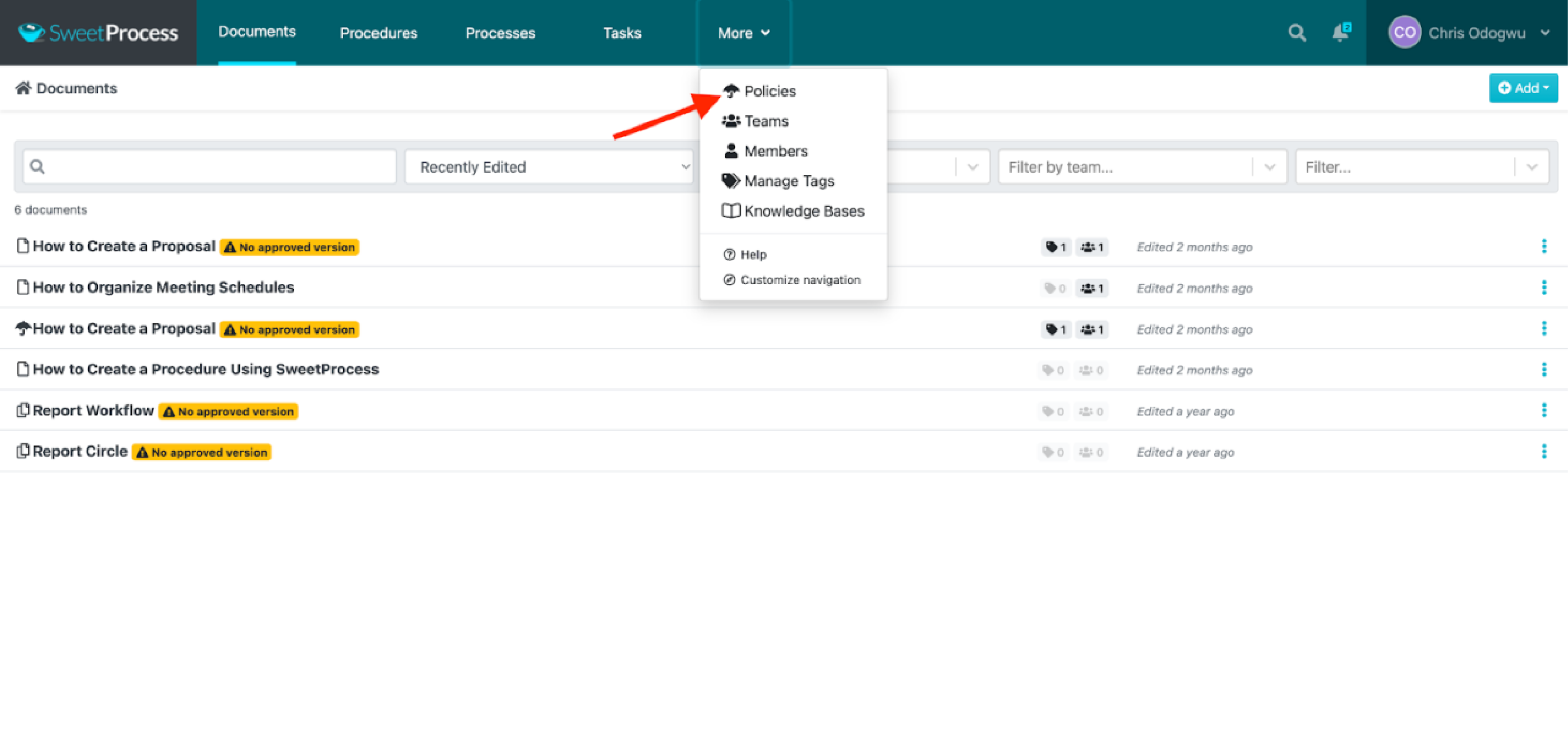
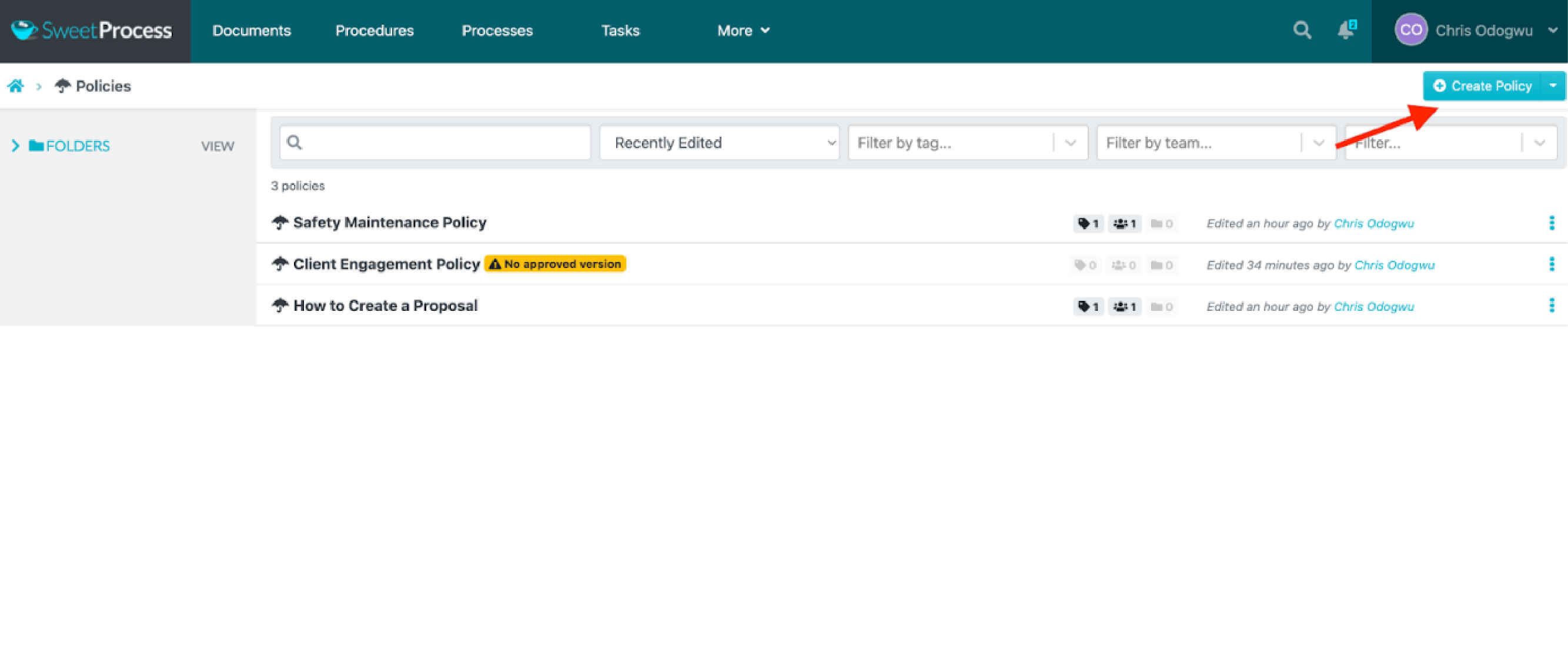
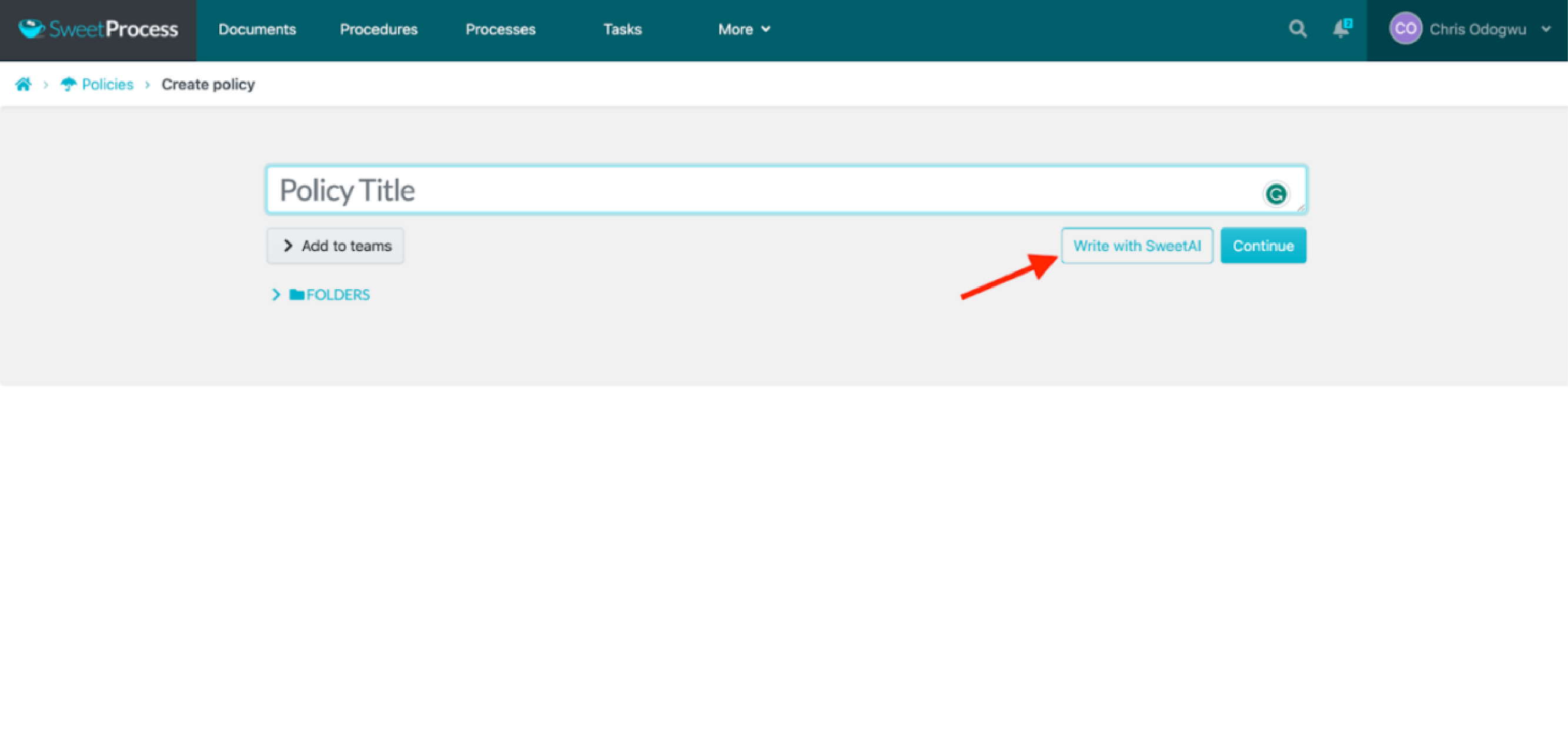
Enter the policy title and click on “Write with SweetAI.”
How to Create a Knowledge Base in SweetProcess

SweetProcess facilitates continuous learning by allowing businesses to create private and public knowledge bases. A private knowledge base is an internal resource for team members to retrieve information on policies and how to perform tasks, while a public knowledge base is a resource available to customers and members of the public about an organization’s services. A common example of a public knowledge base is a frequently asked questions (FAQs) page.
How to Create a Private Knowledge Base in SweetProcess
Click on “More” at the top and then click on “Knowledge Bases.”
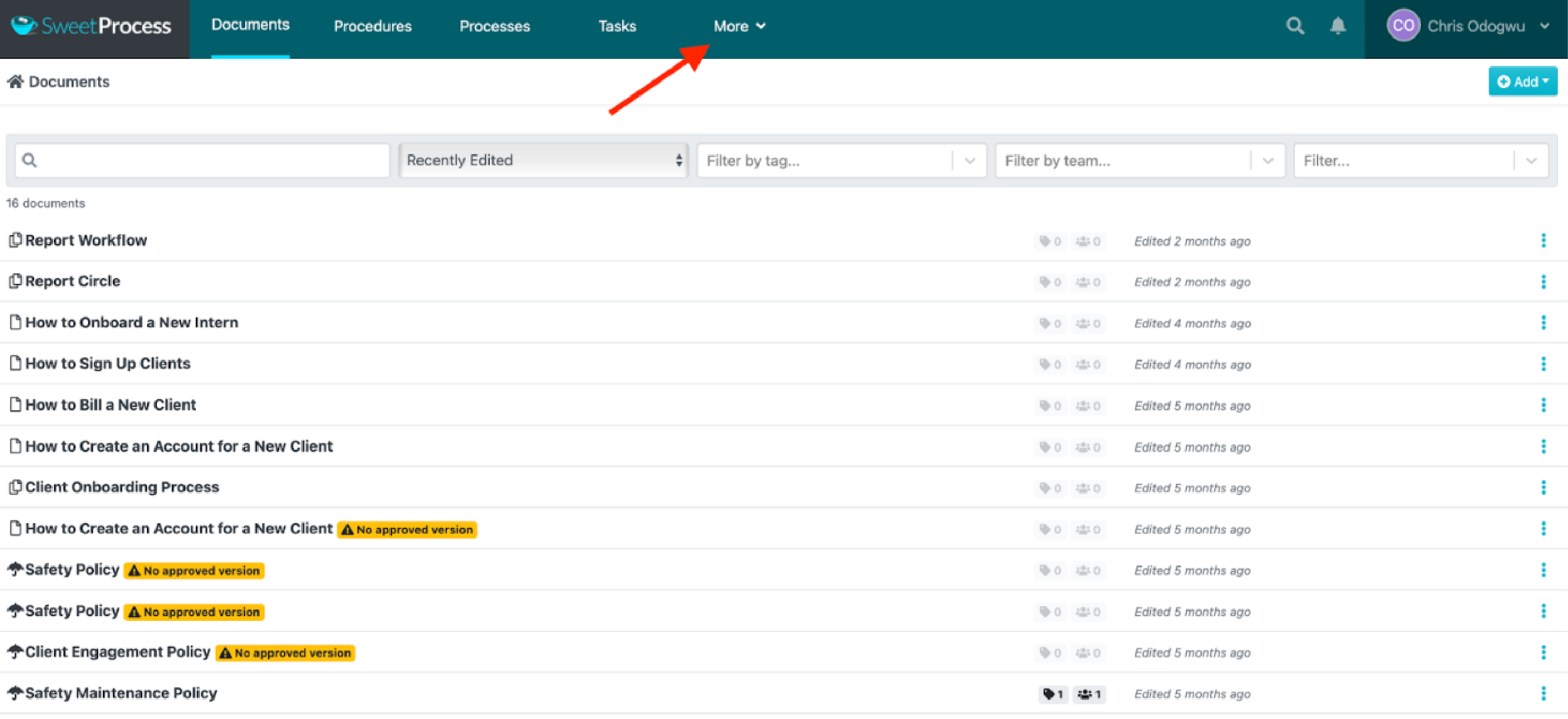
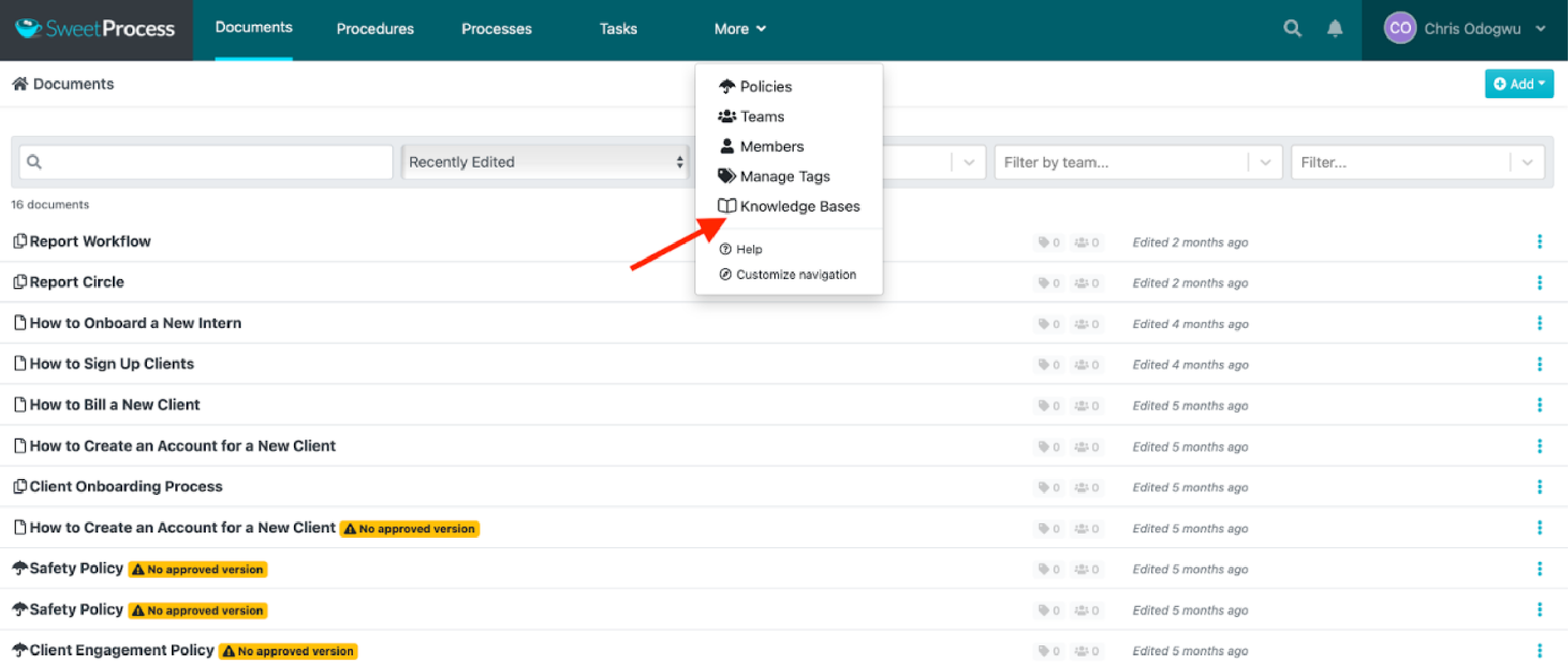
Click on “Create Knowledge Base.”
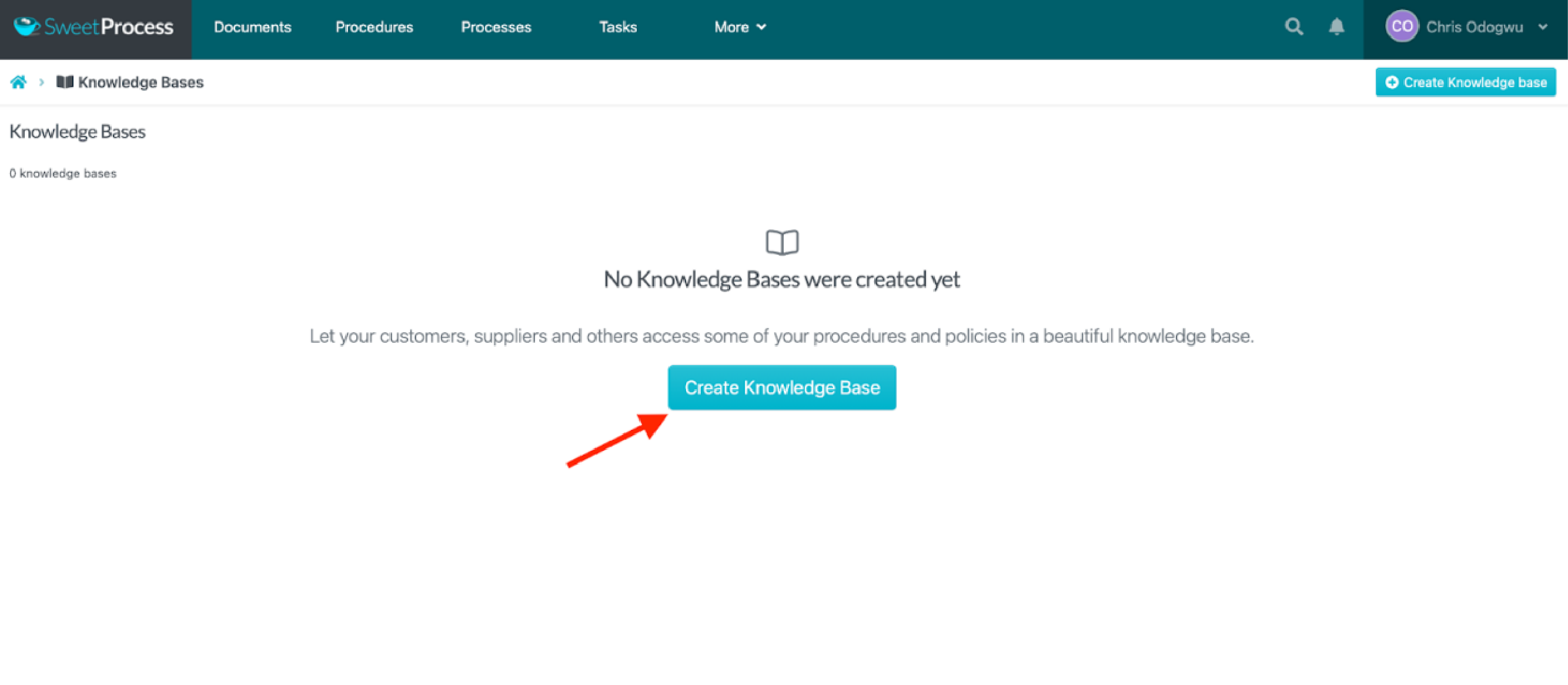
Enter the knowledge base title and click on “Continue.”
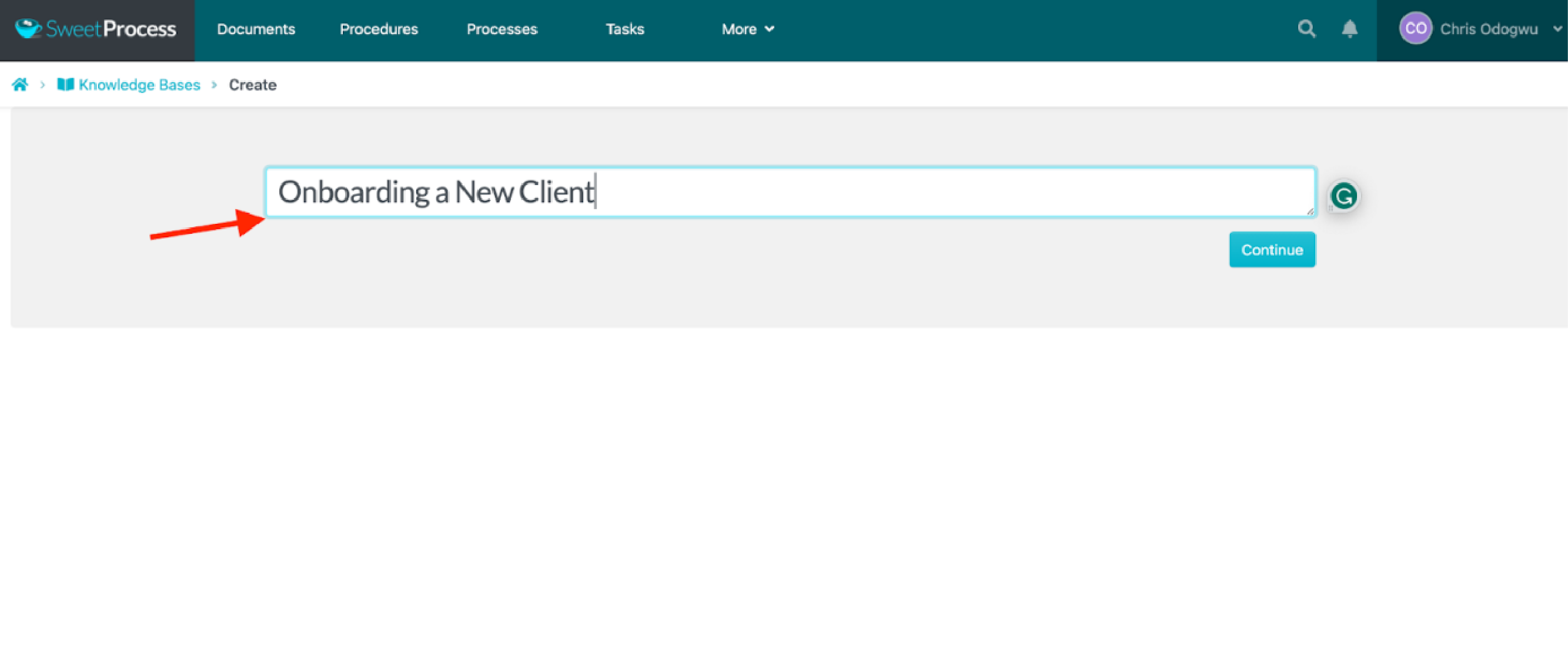
Click on the pencil icon beside the title.
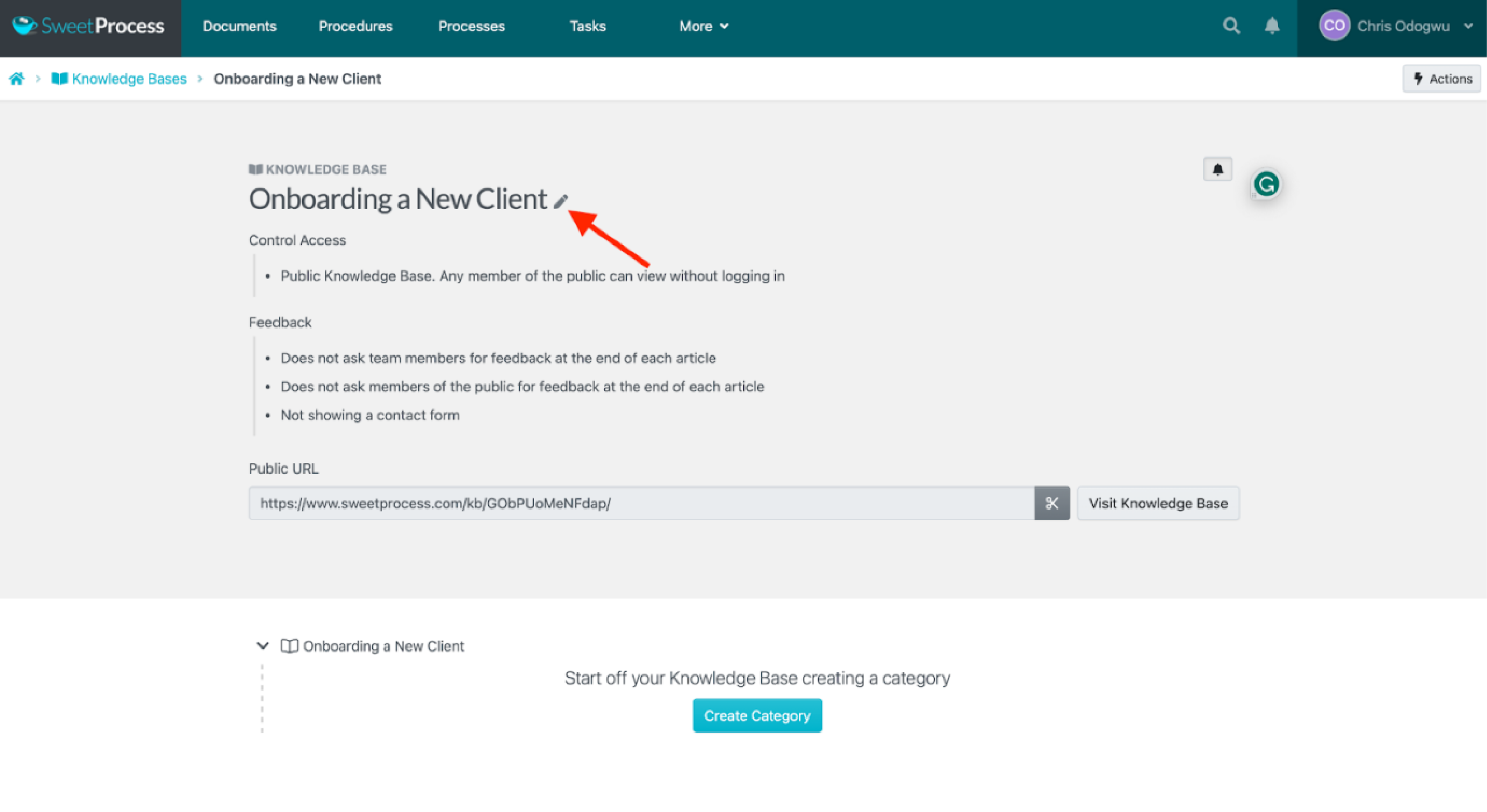
Click on the column below “Control Access” and select “Private Knowledge Base, only logged-in team members may view (if they have the necessary permission).”
Enter the URL you want team members to be redirected to when they click on the knowledge base.
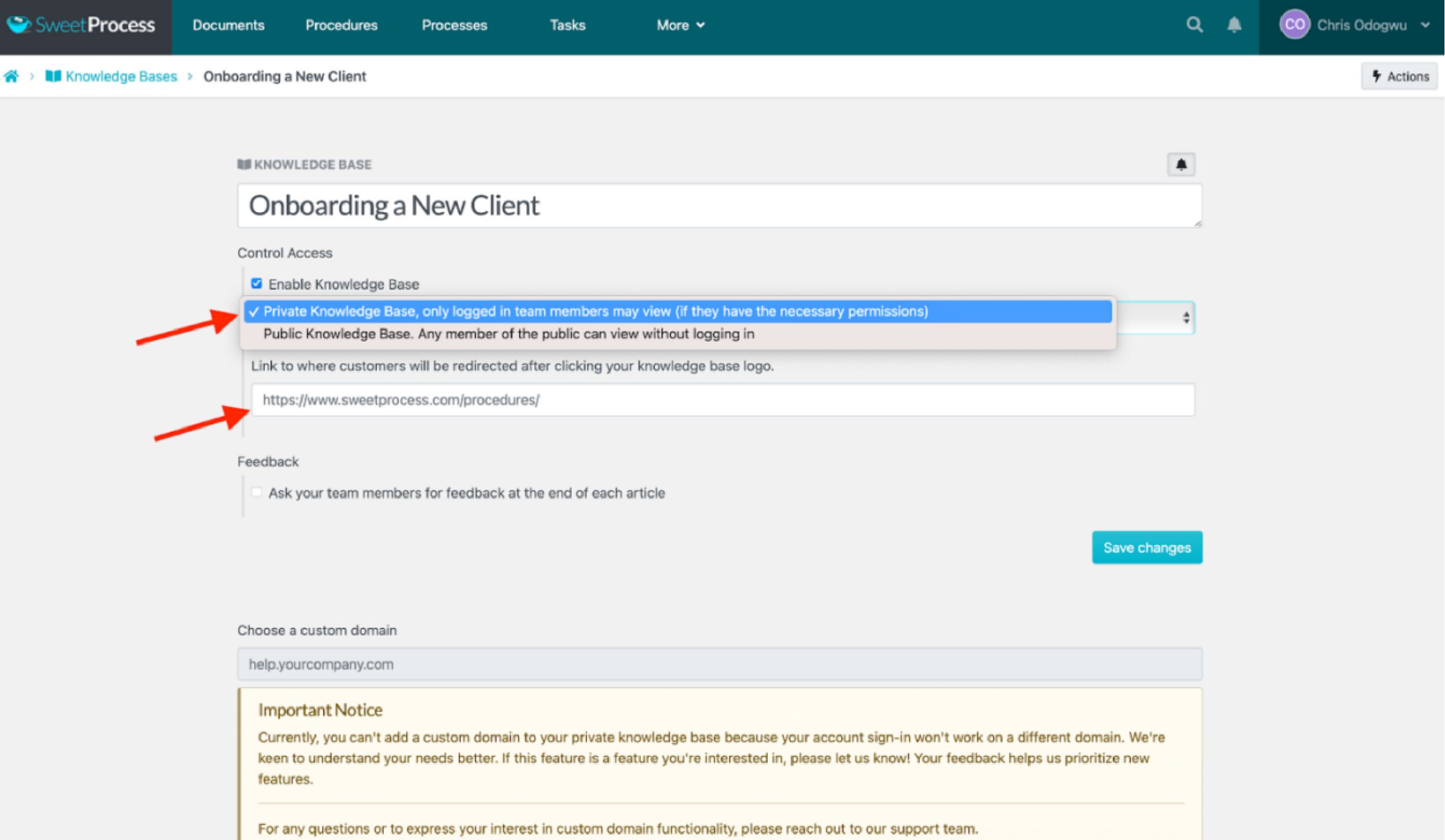
How to Create a Public Knowledge Base in SweetProcess
Click on “More” at the top and then click on “Knowledge Bases.”
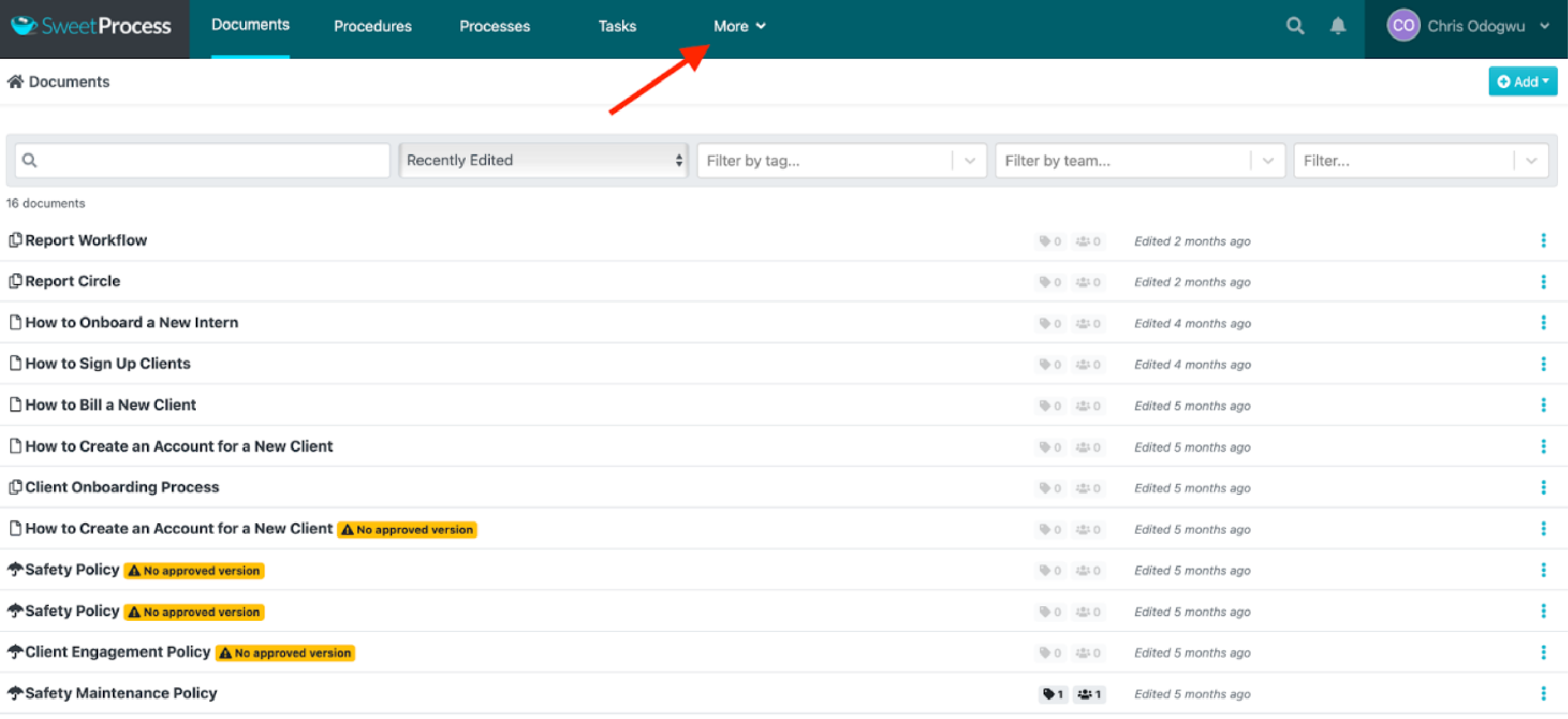
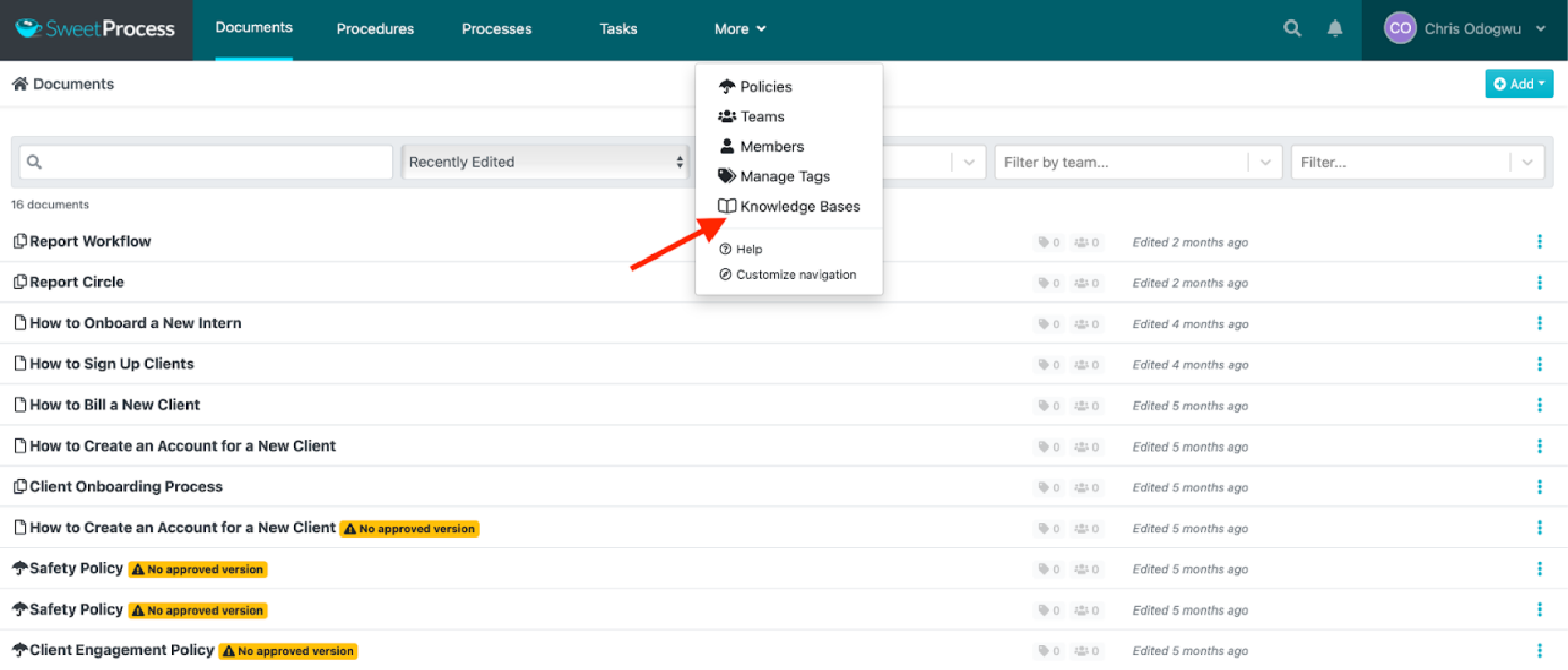
Click on “Create Knowledge Base.”
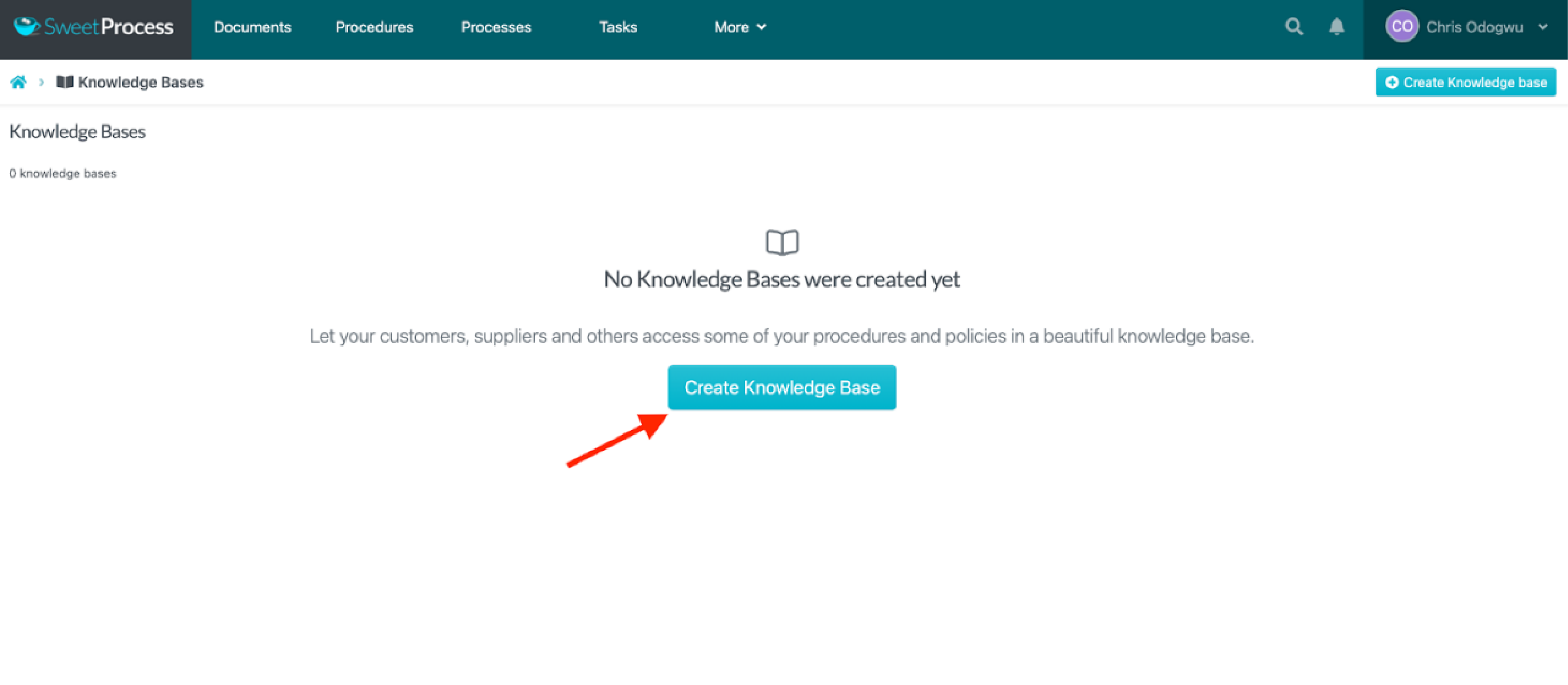
Enter the knowledge base title and click on “Continue.”
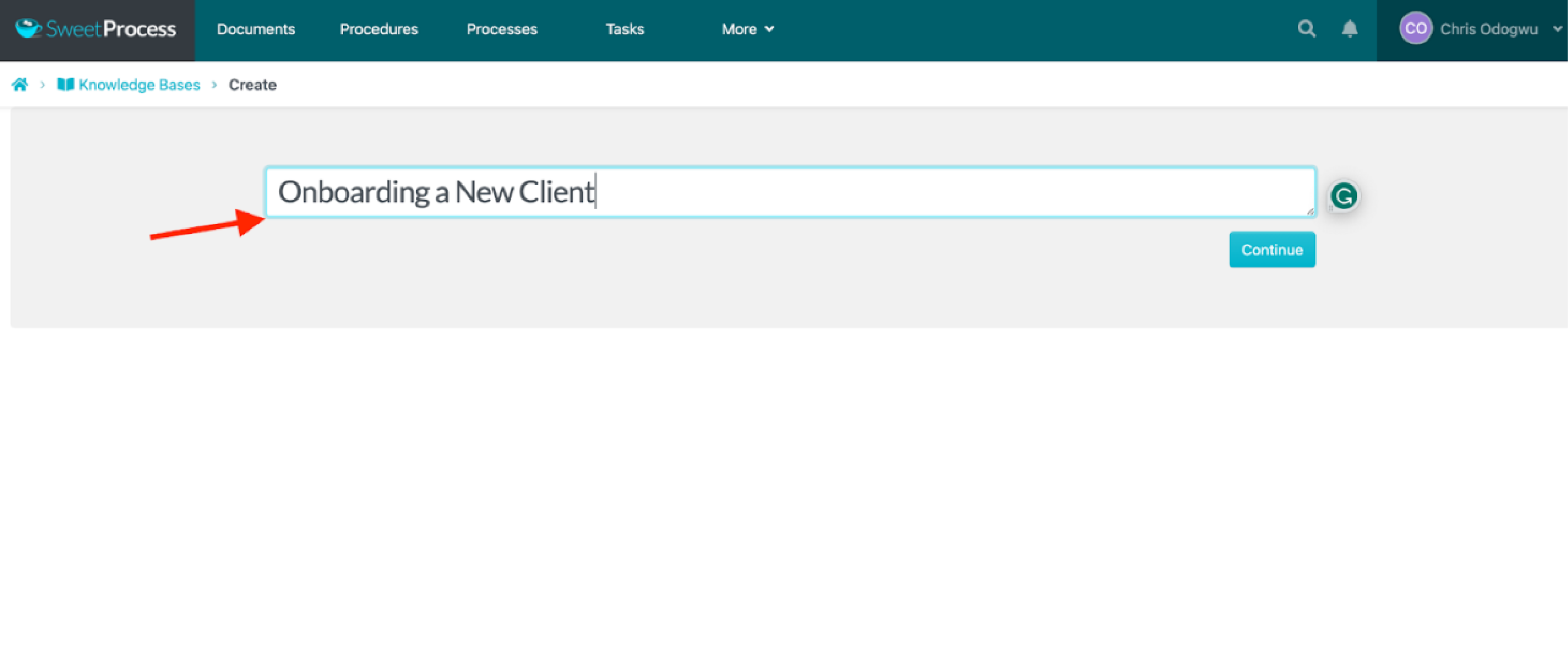
Click on the pencil icon beside the title.
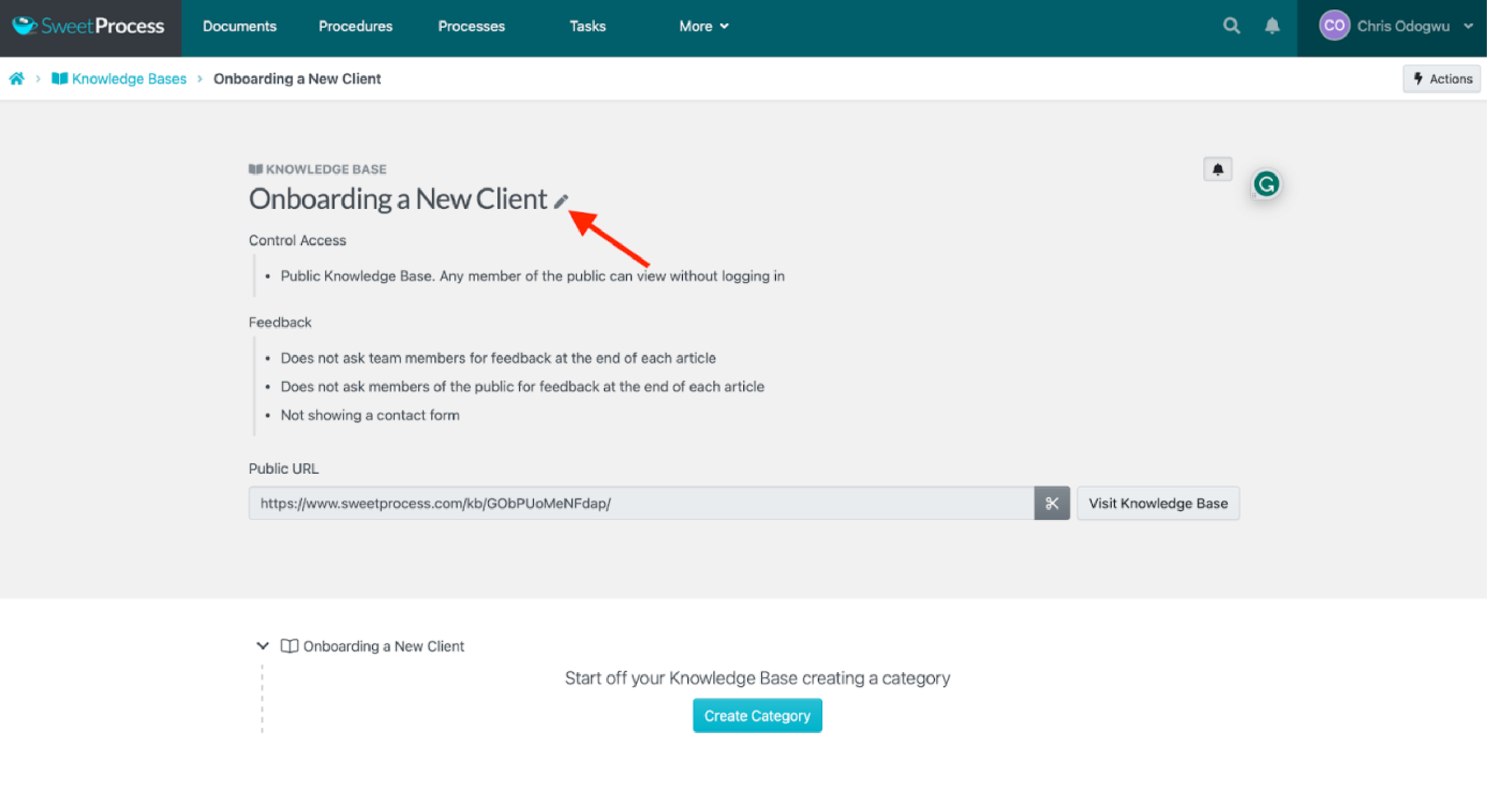
Click on the “Control Access” column below and select “Public Knowledge Base. Any member of the public can view without logging in.”
Enter the URL you want customers to be redirected to when they click on the knowledge base.
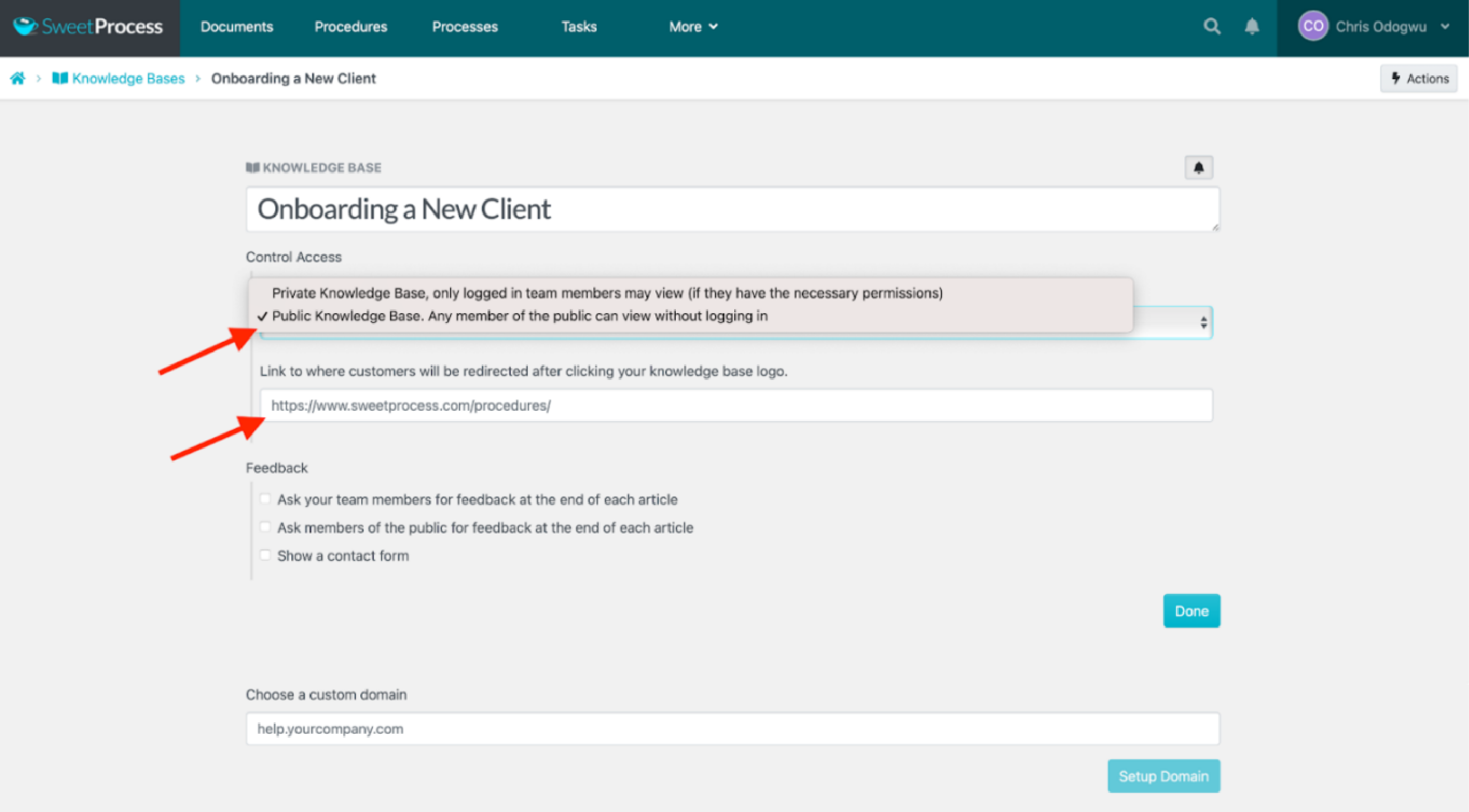
You can also redirect customers to a custom domain.
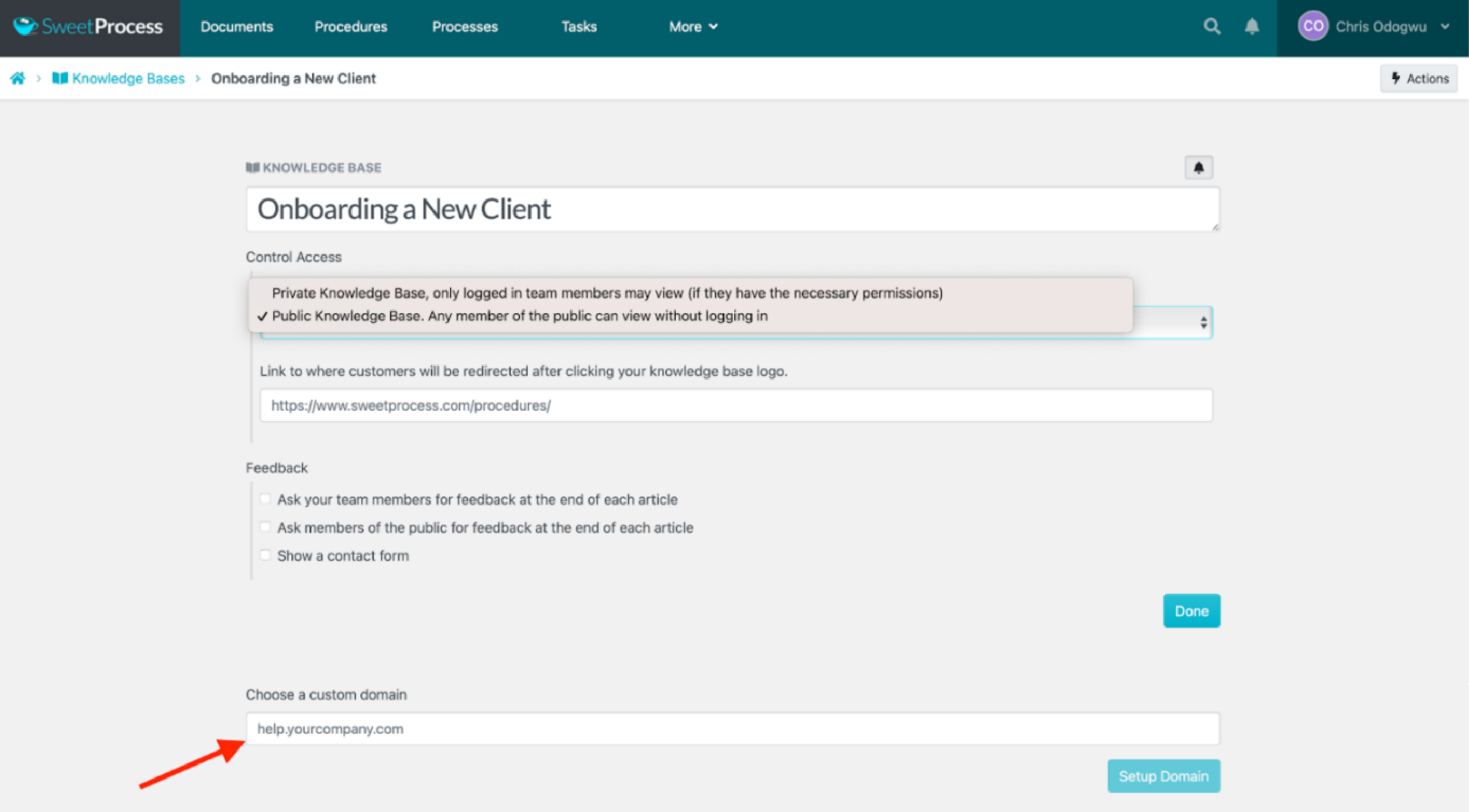
How to Document Procedures and Processes Using SweetProcess

Procedures are the how-to instructions for performing individual tasks, while processes are a series of procedures for performing longer or complex tasks.
SweetProcess offers you the option of creating your procedures either manually or automatically. The automatic alternative is your best bet to save time. At the click of a button, you can use its content creation system, SweetAI, to create standard operating procedures in seconds.
How to Document a Procedure Manually in SweetProcess
Click on “Procedures” and then click on “Create Procedure.”
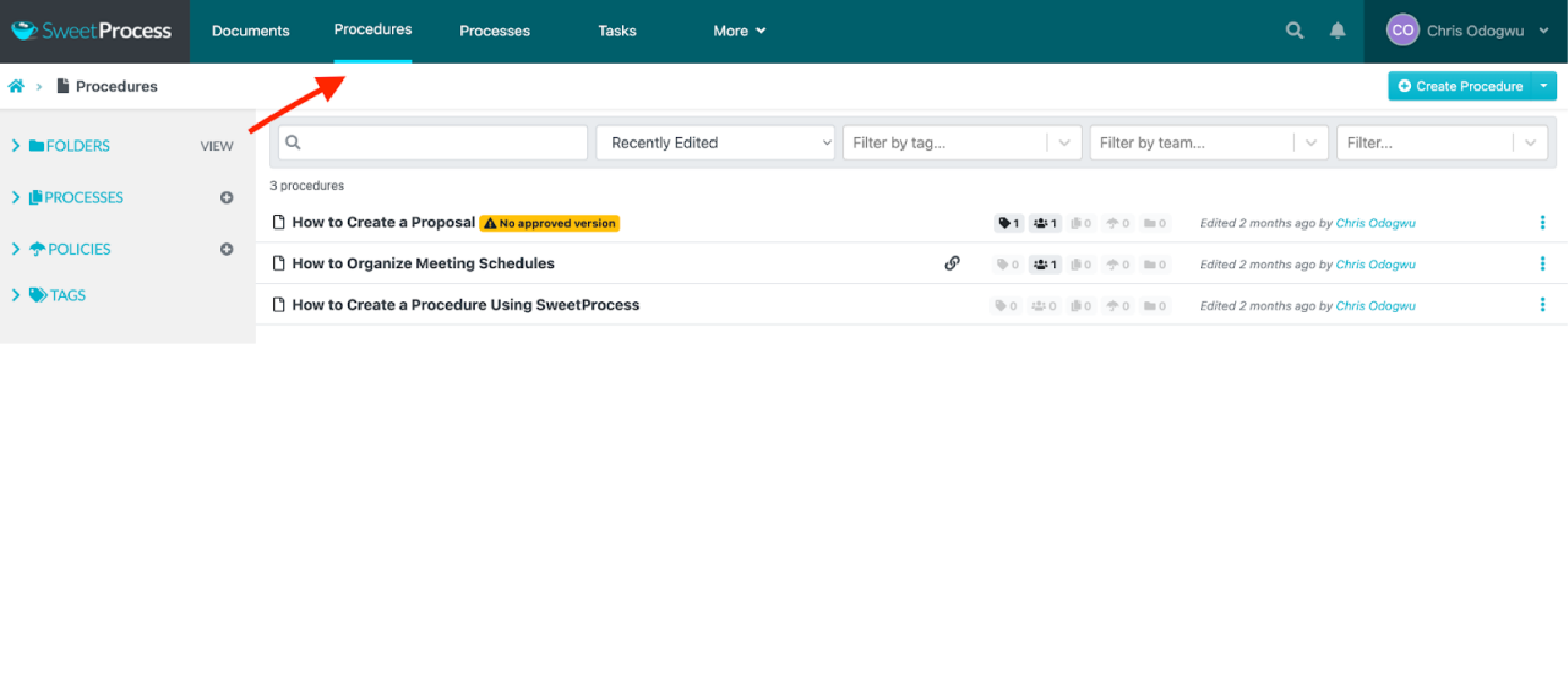
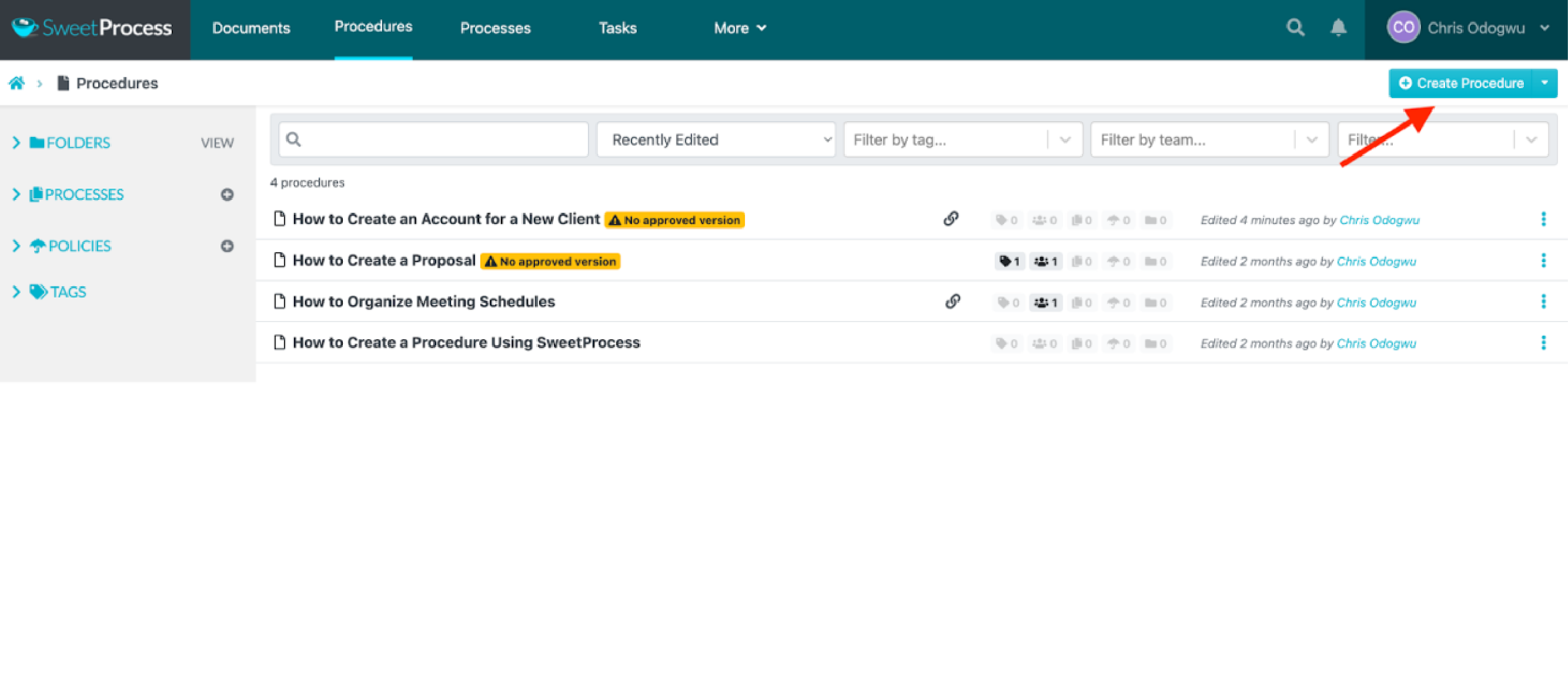
Enter your procedure title and click on “Continue.”
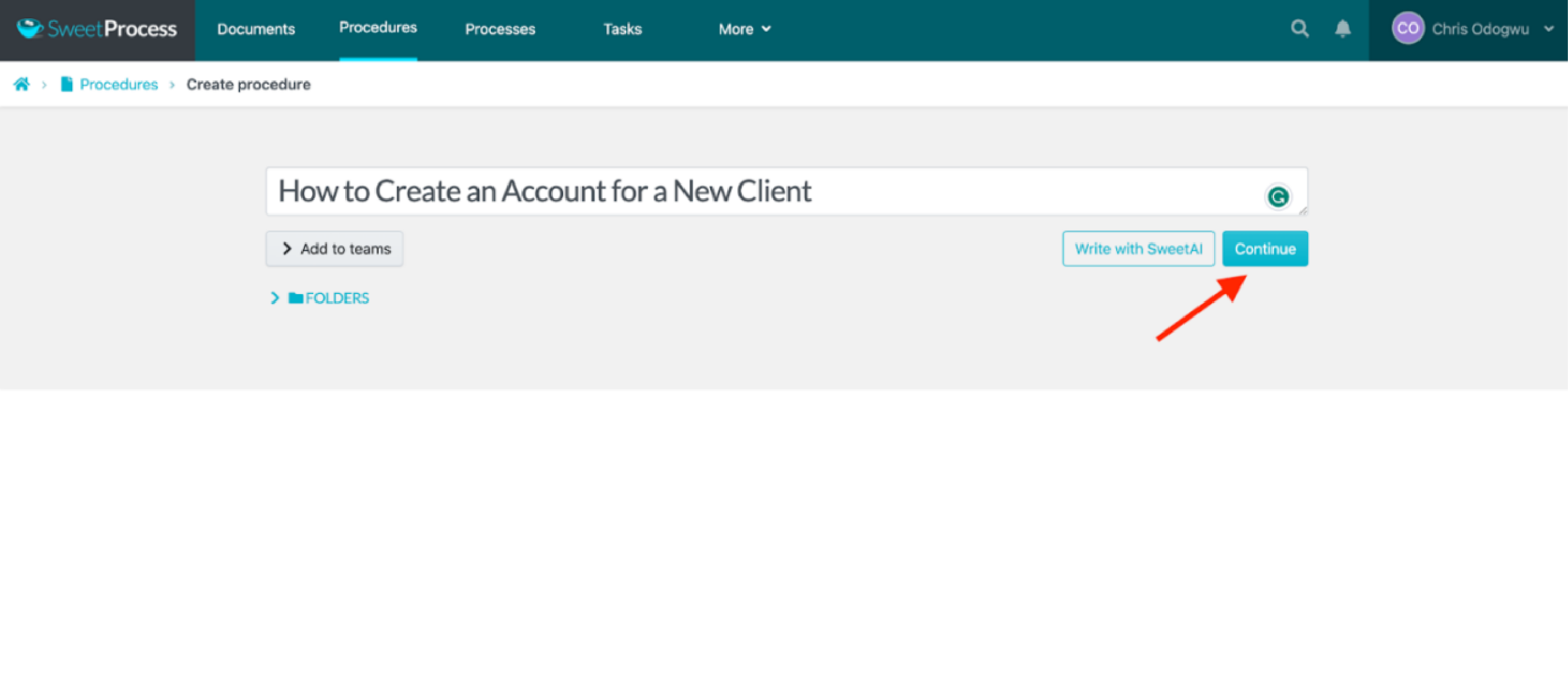
Click on the pencil symbol beside the title.
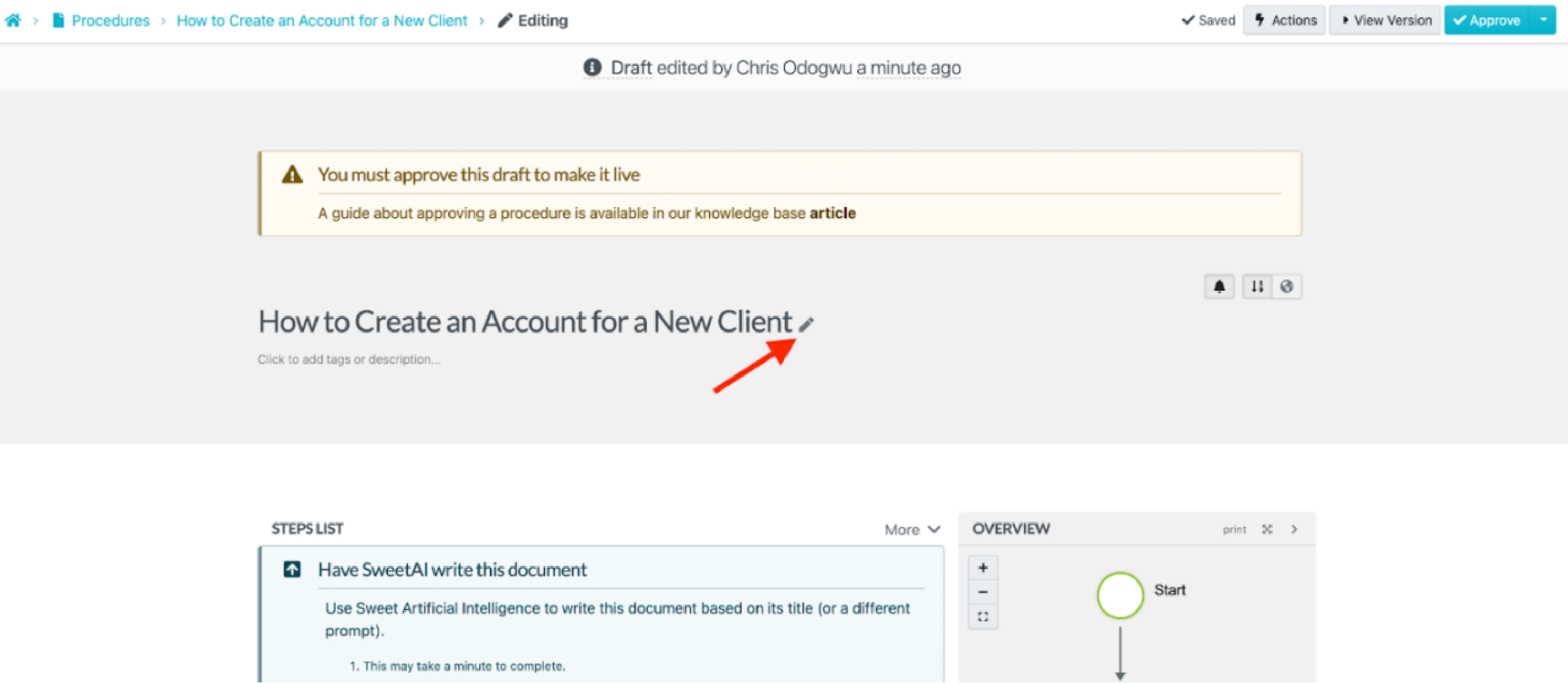
Enter the details of your procedure and click on “Finished Editing.”
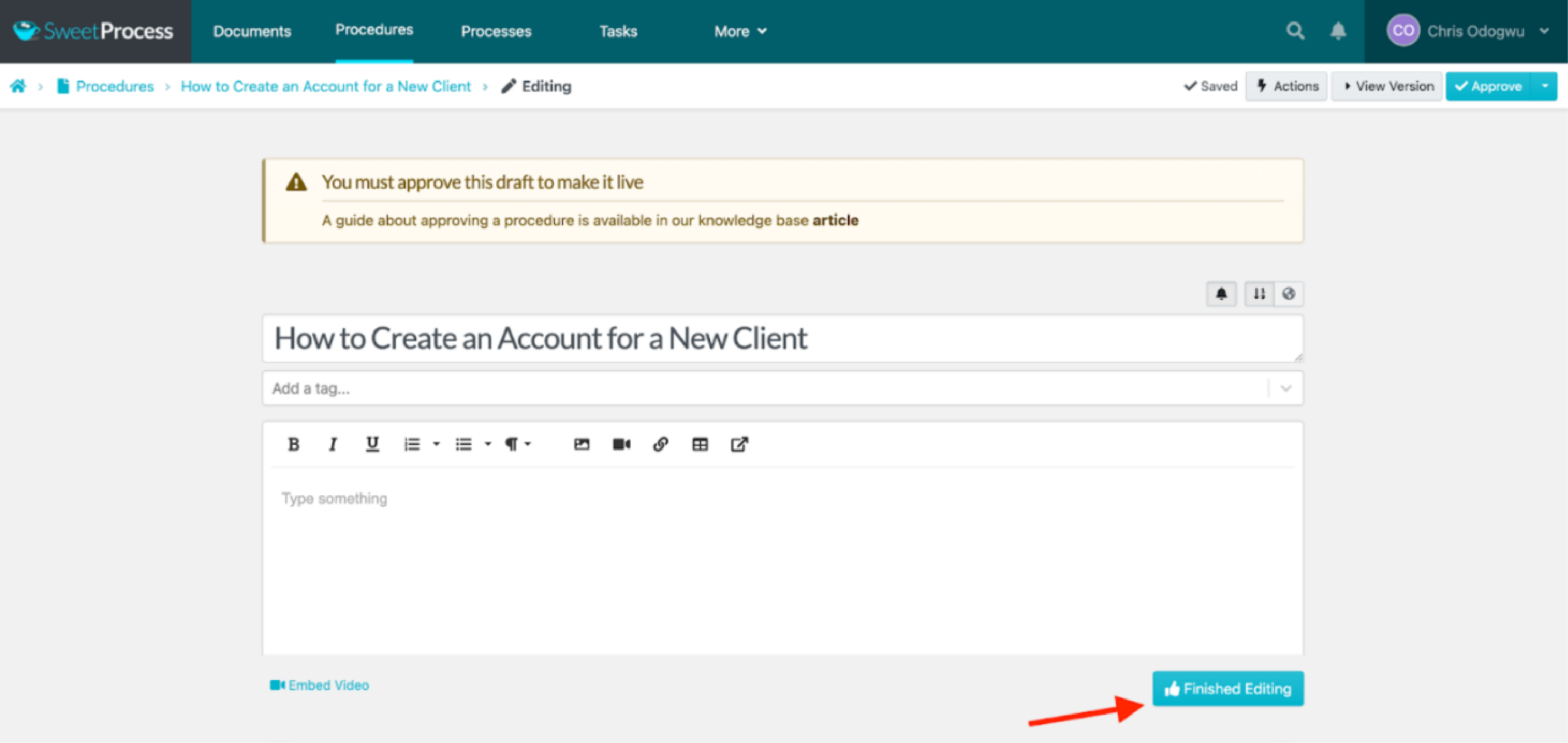
How to Document a Procedure in SweetProcess Automatically With SweetAI
Click on “Procedures” and then click on “Create Procedure.”
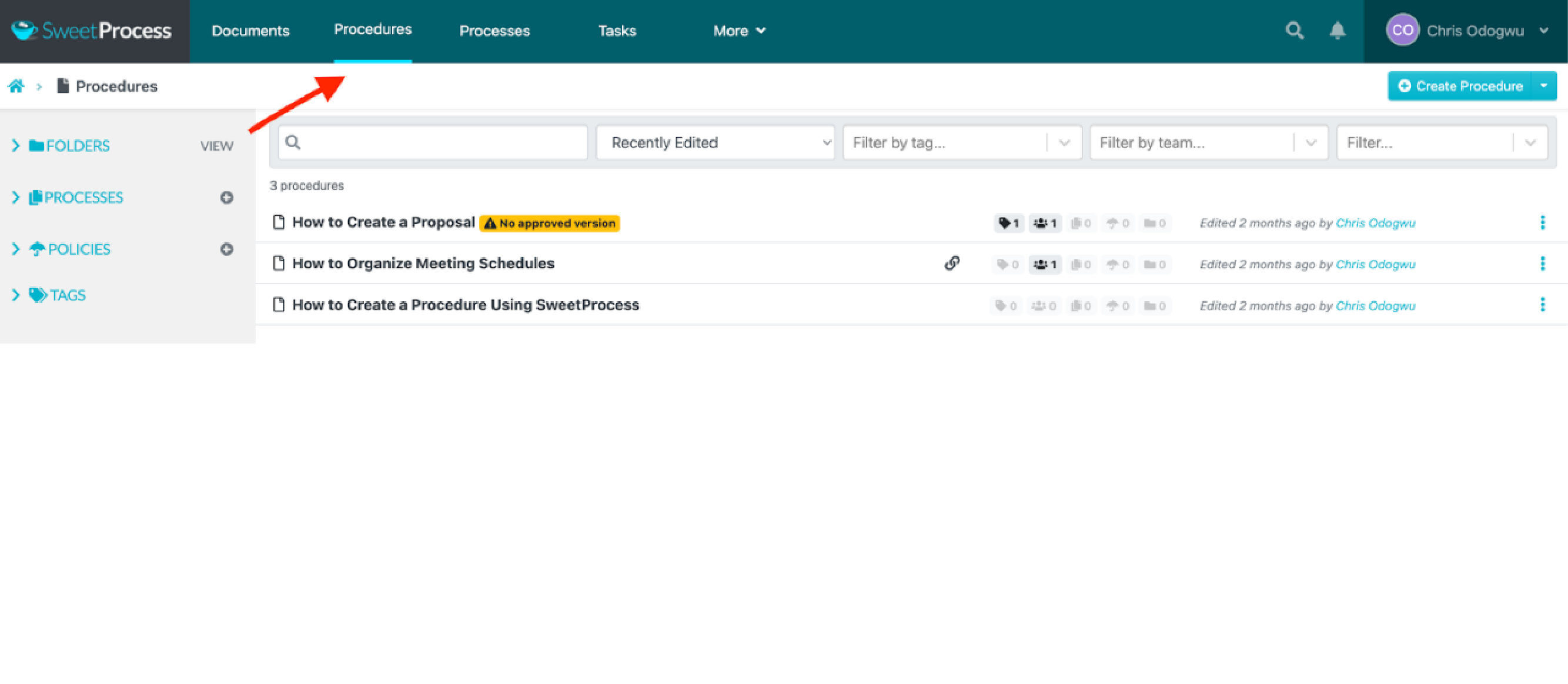
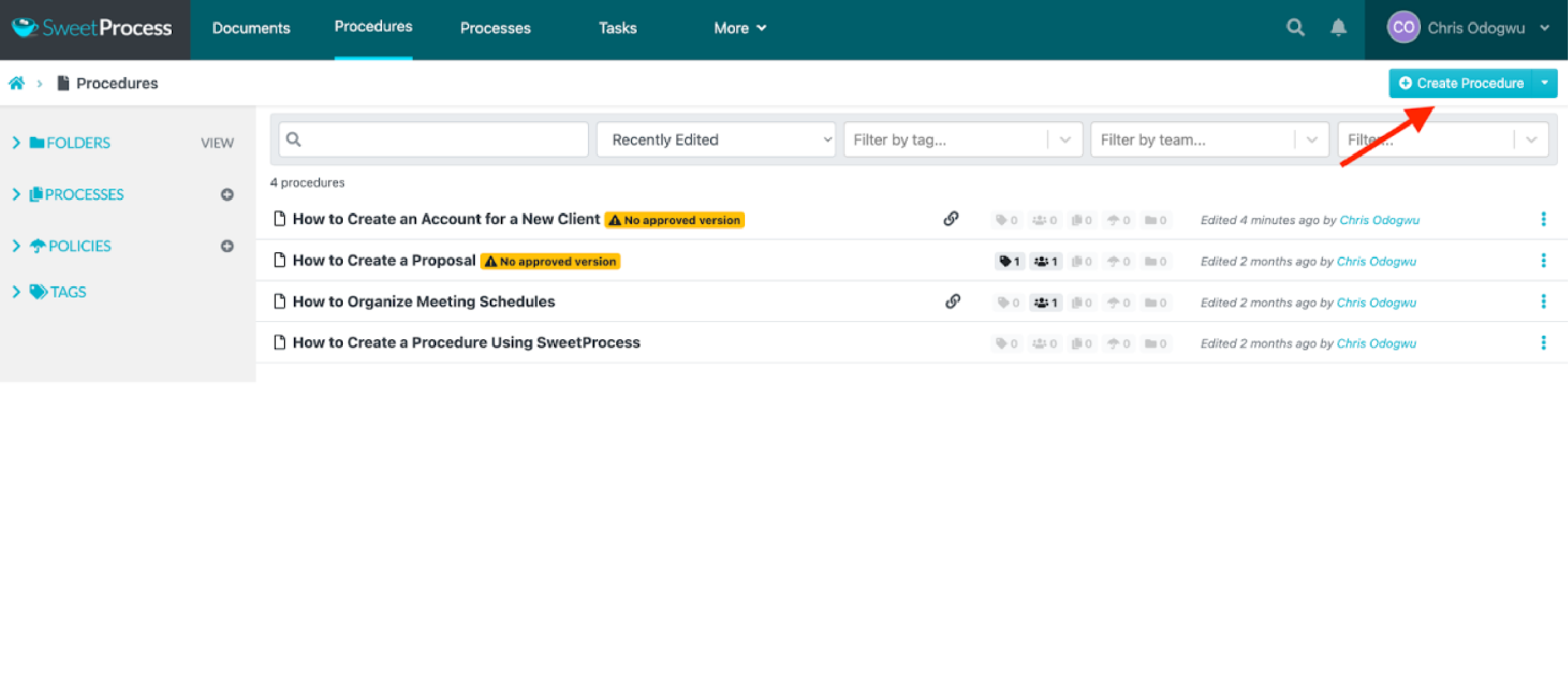
Enter the procedure title and click on “Write with SweetAI.”
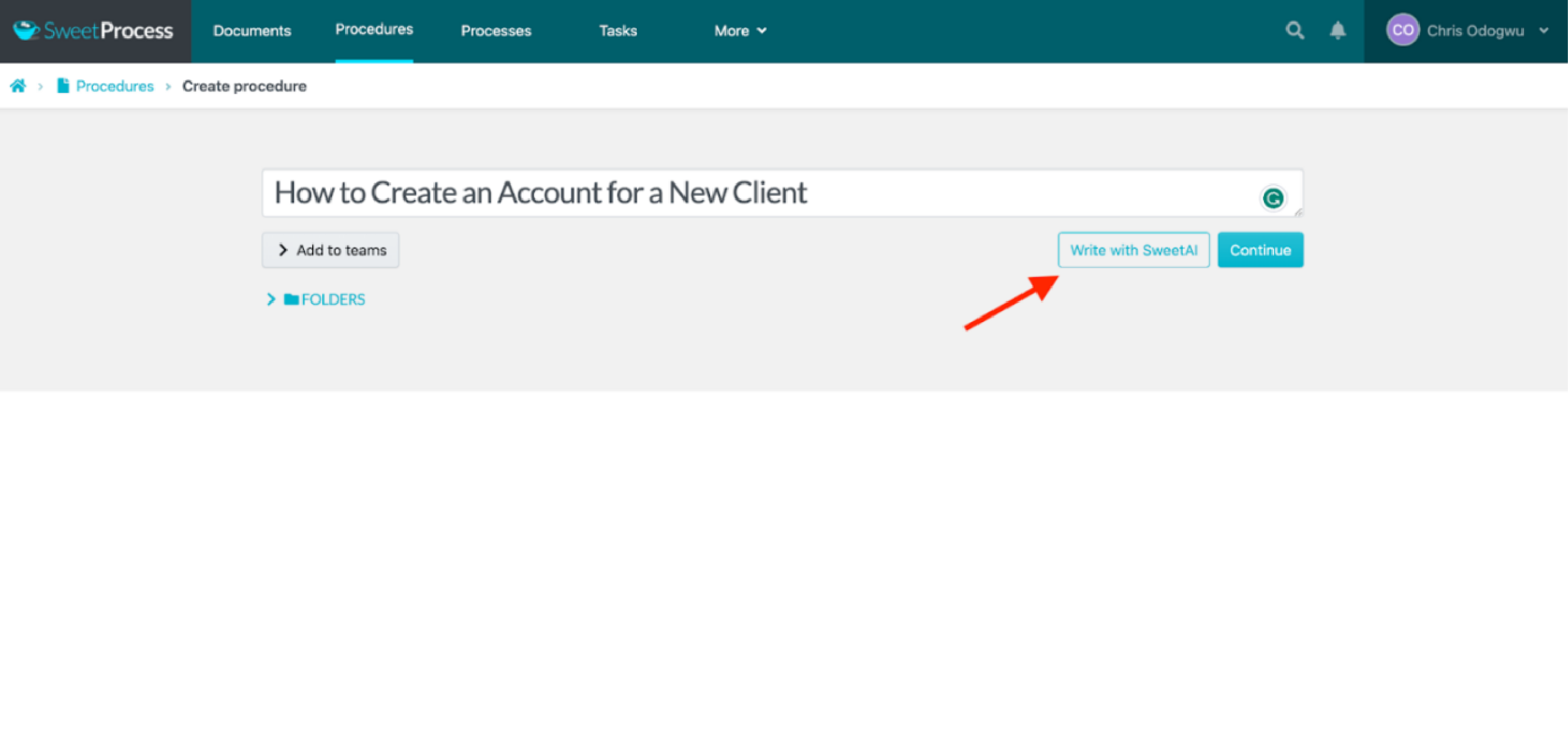
Click on the pencil icon to edit the content if you want.
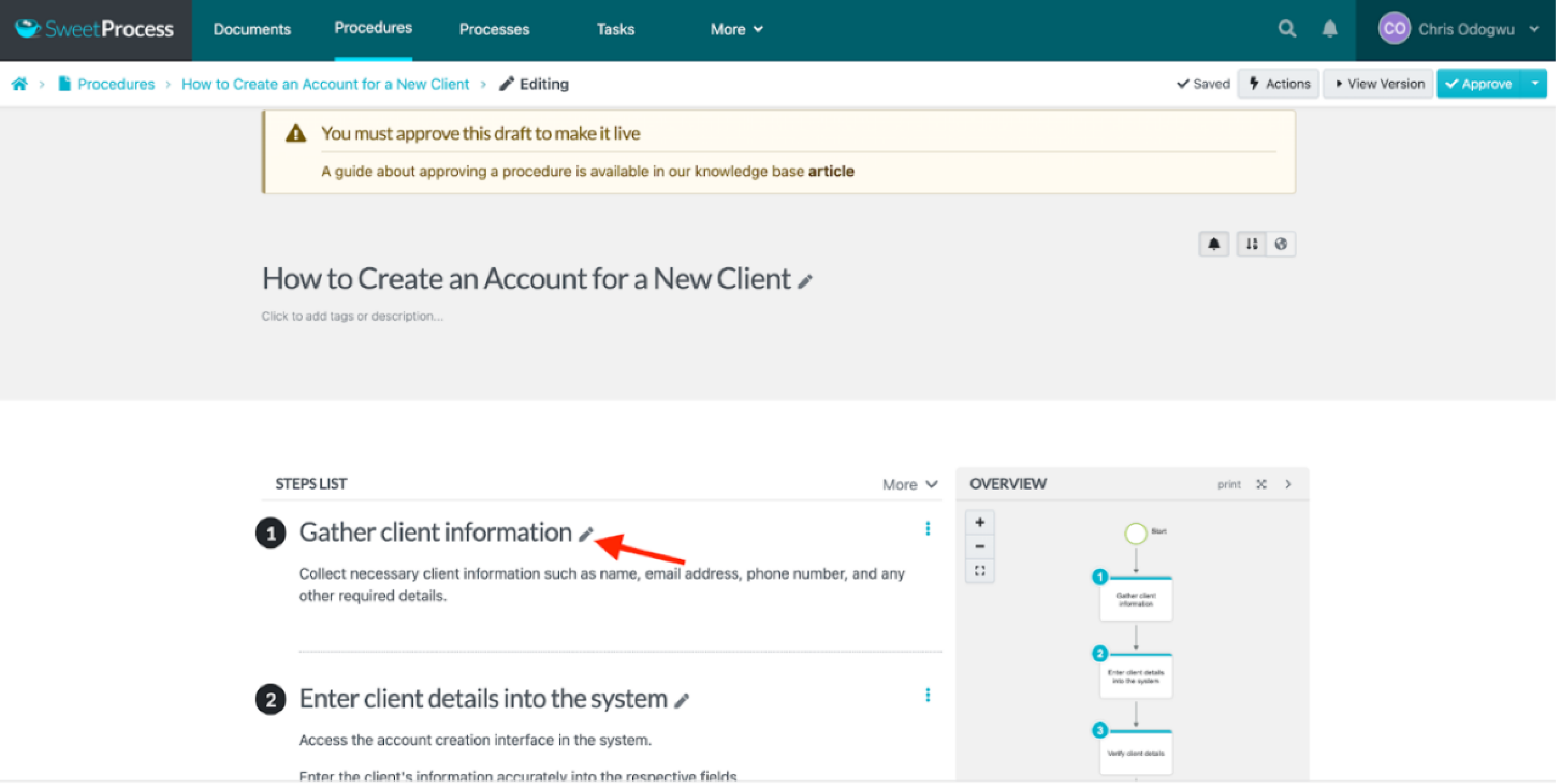
Click on “Approve” to publish the document.
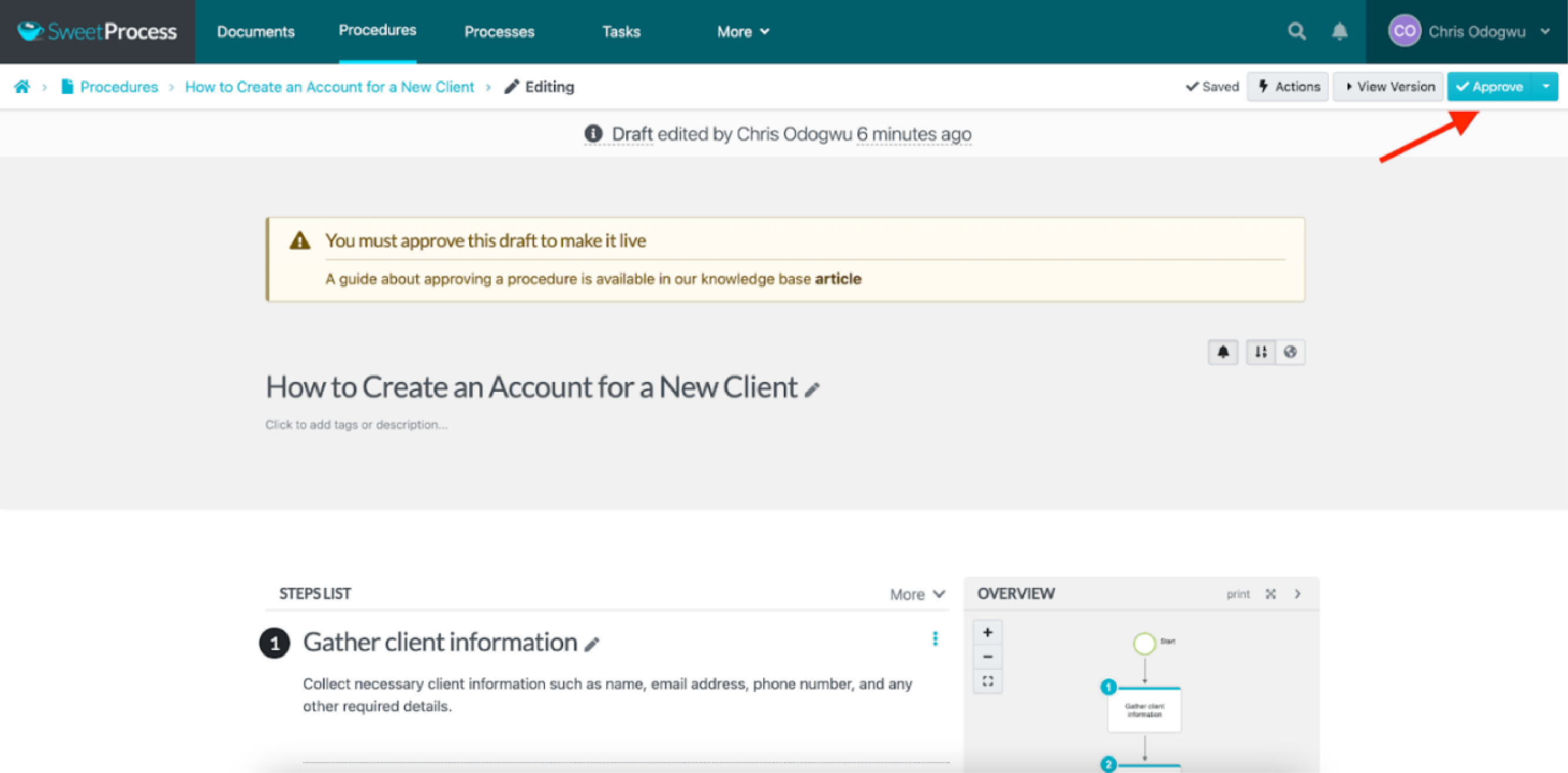
How to Create an Employee Onboarding Checklist in SweetProcess

The steps for creating a procedure are similar to those for creating an employee onboarding checklist. After creating the procedure, here’s how to turn it into a checklist.
Click on “Procedures” and click on the checklist document, which you must have already created as a procedure.
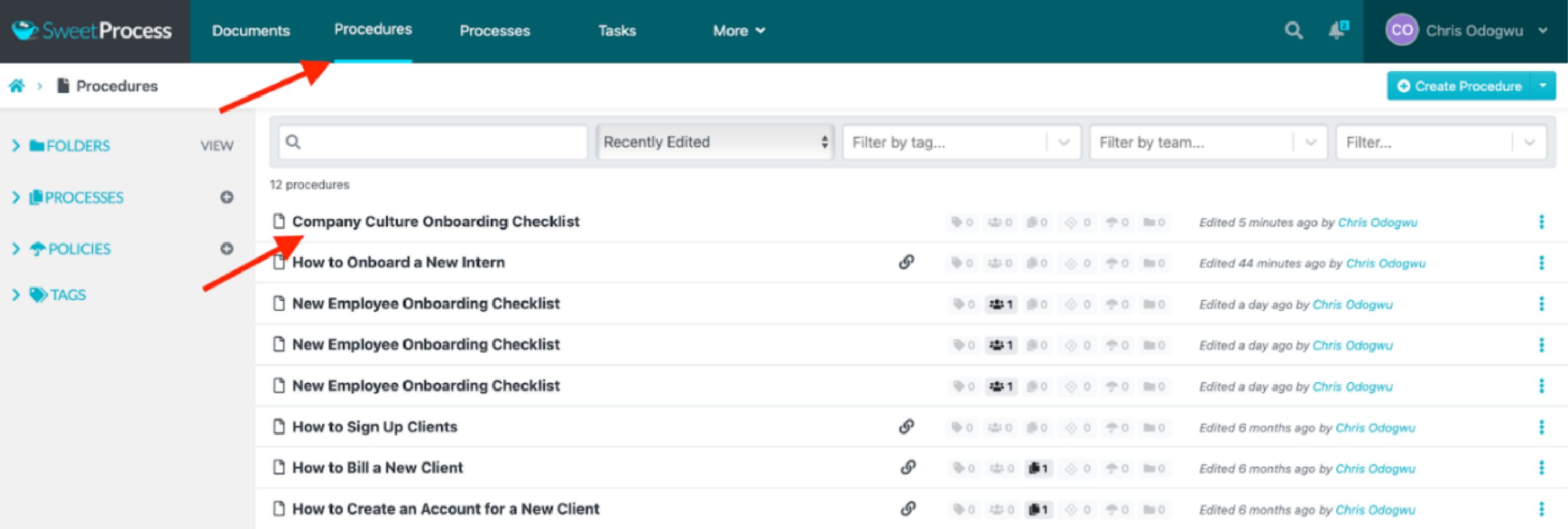
Click on the box next to the notification bell to select if you want the steps in the checklist to be ticked off sequentially or otherwise.
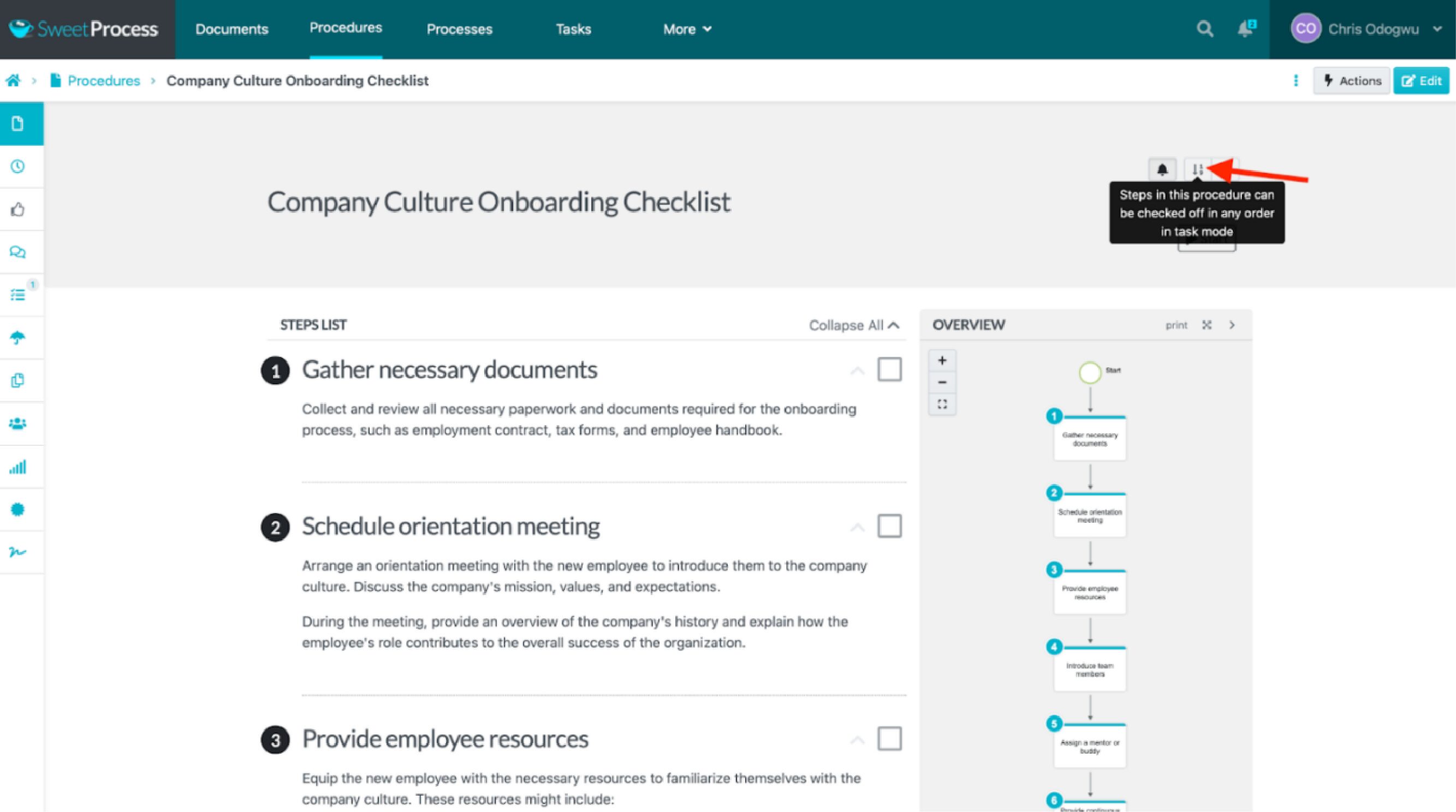
To add a form field to any steps, click on “Edit.”
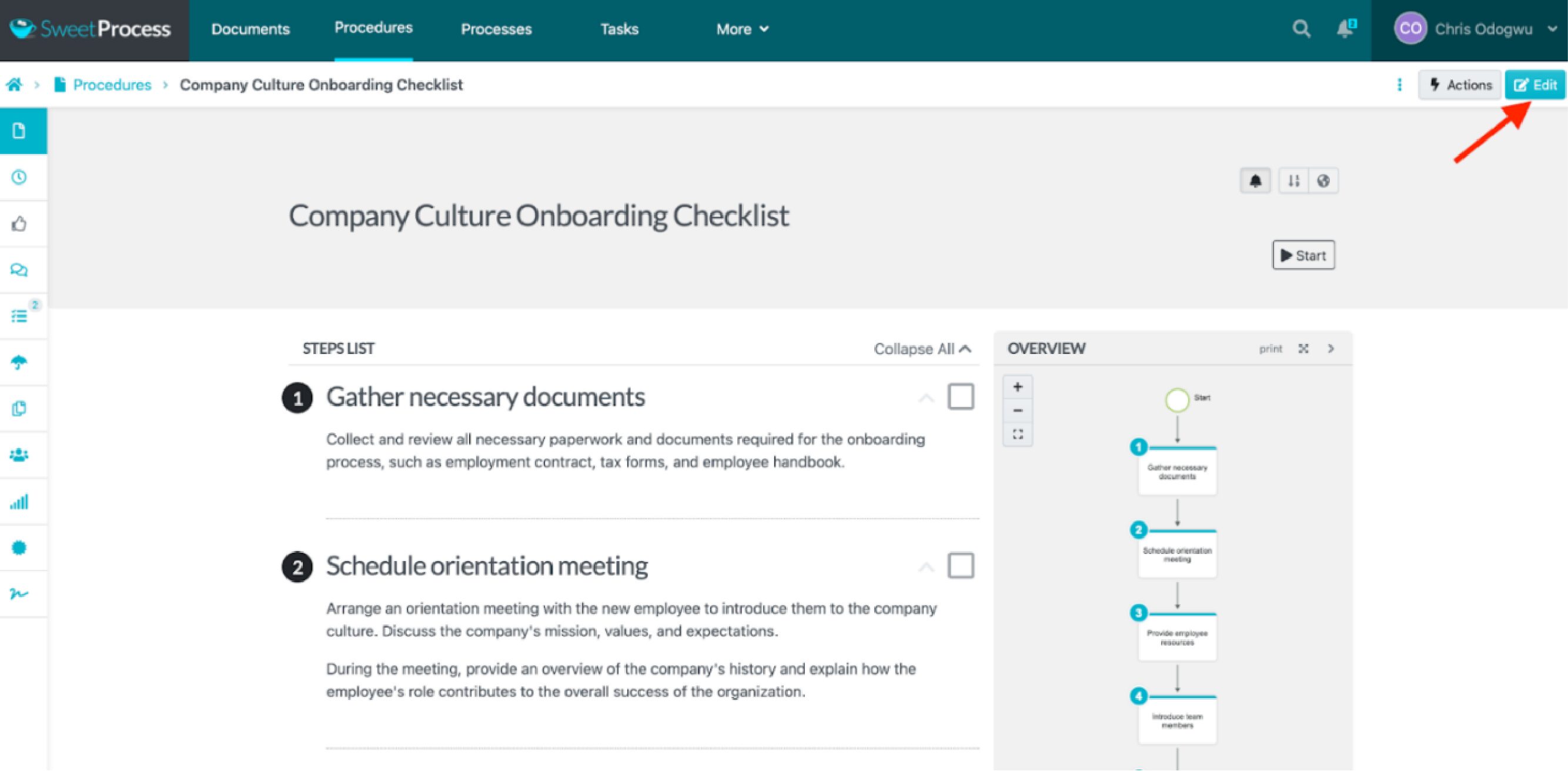
Click on the pencil icon beside the step.
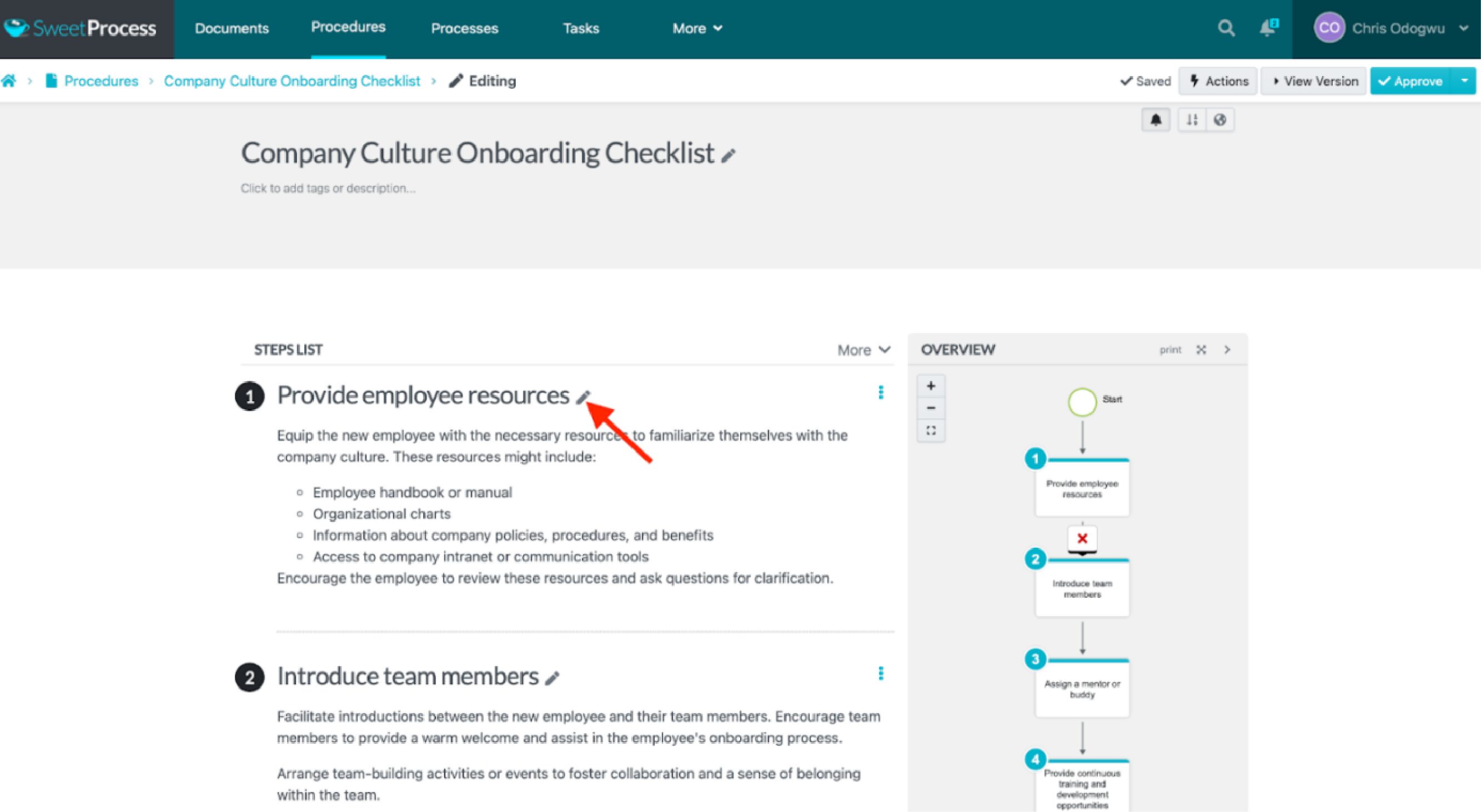
Click on “Add Form Field” and select an item from the menu.
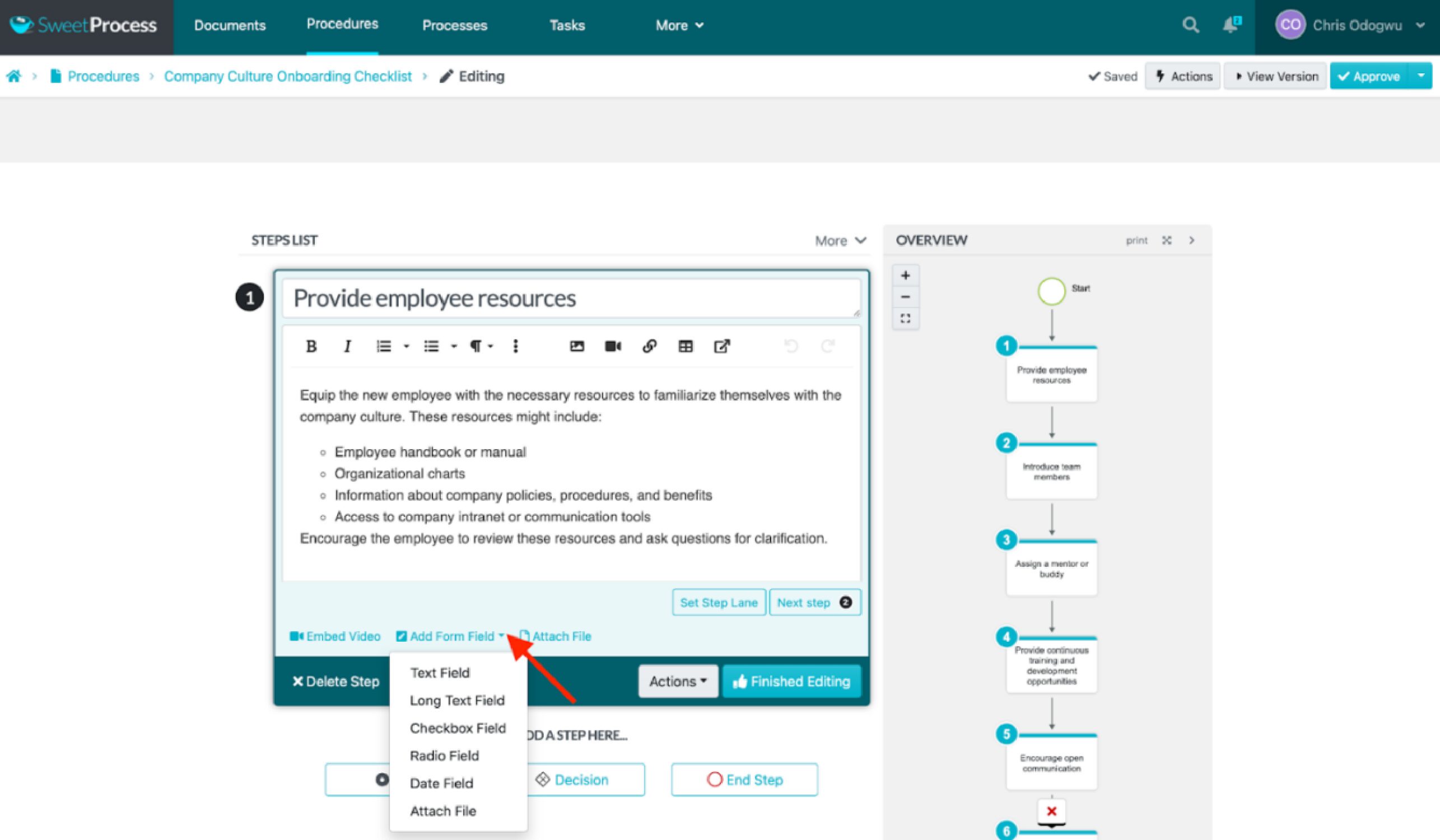
The above SweetProcess tools aren’t theory-based but practical. Many organizations use them to onboard new and established employees, and the results are amazing. One of such organization is CFO Services Group, a financial institution. Its president and chief executive officer, Manny Cosme, reveals that he uses SweetProcess to streamline the company’s employee onboarding process, which enables new hires to perform significant tasks within two weeks.
“It’s so much easier. We can train a new employee within two weeks now, from the time that they start day one. It’s just them shadowing and looking at what we’re doing, and then week two is them doing it on their own using SweetProcess as a guide. By the end of week two, everyone has been trained,” Cosme says.
The right tools simplify the most tedious tasks. You can make employee onboarding a simple and rewarding activity for both your organization and your employees by using SweetProcess. Sign up for a 14-day free trial without a credit card.
Stages of Employee Onboarding: How to Integrate New Hires Into Your Organization

Employee onboarding may not give you the desired outcomes if you don’t do it well. Organizations record different results from onboarding due to the varying methods they adopt. Onboarding is a lot of work. It’s best to break it down into multiple stages for best results.
Pre-Onboarding
Offer and Confirm Acceptance
Having decided on employing a candidate, the first step in the hiring process is to make them an employment offer. This letter begins your official engagement with the candidate. Its language and tone speak volumes about your organization’s values. Keep it professional but warm. If the candidate accepts the offer, assure them of their place in the organization by confirming their acceptance.
Prepare Paperwork and Documentation
Keeping new hires waiting too long after confirming their acceptance shows that you aren’t ready to bring them in. Handle general logistics about their employment before making them an offer so that once they accept it you can commence the necessary documentation.
Setup Accounts
The tech tools employees need for work should be ready at this stage. Set up their user accounts and other resources for accessing apps such as company websites, workflow management tools, and apps like Slack and Microsoft Teams so they can join other team members.
Setup Payment Details
Payment delays worry established employees, let alone new ones. Avoid any payment issues by setting up their payments as soon as possible so you will have enough time to resolve challenges that may arise. Offering flexible payments helps simplify the process as employees have more options.
First Day
Welcome and Introduction
Many new employees struggle to settle into a new workplace. It’s your responsibility as an organization to make them feel welcome. This is easier to do if the entire team is receptive. Established workers should not see the new ones as threats but as teammates who have come to assist them achieve organizational goals. Introduce new employees to everyone and create opportunities for interactions.
Sign Paperwork
It’s best to have employees sign key documents about their employment before their first day at work, but if, for any reason, some documents are pending, ensure that they sign them before the day ends. This is to solidify the legalities of their engagement, especially as they have become privy to the internal environment of the organization.
Grant Access to Workspace and Tools
Candidates who make it to the first day at work are bonafide employees—they should have access to the company’s digital workspace and tools like their established colleagues. Check with them to confirm that their accounts, apps, and access privileges are active.
Orientation Session
An orientation session familiarizes new employees with how things work in an organization. They get a closer look into the organization’s culture, values, policies, etc. Unfortunately, most orientation sessions are boring, with participants hoping they end soon. There’s a thin line between providing a new hire with relevant information and too much information. Keep the new employee orientation brief by sticking to the most relevant information. There’s more time for them to learn about other aspects of the company.
Facility Tour
A highlight of employee onboarding on the first day is a tour of the facilities if they are working in person. Show them key areas of the establishment and briefly explain how they function. Pay attention to the facilities they will be using for their work to build some familiarity.
Introduction to Immediate Team
After introducing new hires to the general staff members, seize the right opportunity to introduce them personally to the team members they will be working with. Their ability to rapport with immediate team members enables them to settle in faster and get the hands-on help they need on the job.
- Assign Mentor/ Onboarding Buddy
New team members may shy away from seeking guidance from the entire team so they don’t come across as incompetent. They may feel more comfortable speaking to one person. Fifty-six percent of employees reveal that having a mentor enhanced their onboarding experience. Assign a mentor to guide them as they navigate their onboarding tasks and the organization in general. Some employees may gravitate toward certain individuals. Encourage such rapport by assigning that person to assist them with tasks.
Probation Period
Role-Specific Training
Give employees a fair chance in the probation phase by training them on specific tasks they’ll be performing. Provide them with relevant training resources to enhance their learning and ensure they have the technical skills to utilize the resources. A good example of this is to teach employees how to use apps adopted in your organization for work, especially if they aren’t familiar with the apps.
Communicate Performance Expectations
Communicating performance expectations enables team members to focus on work areas that matter most to the organization at that time. Failure to communicate your expectations may have them paying more attention to less important activities, impacting their performance evaluation negatively and decreasing the organization’s output.
Schedule Regular Checking (First Week, First 90 Days, First Year)
There’s always something new to learn about employees’ performances when you check in with them. There may be aspects of their work that can be improved even if they are performing brilliantly. Spread out the meetings so there’s enough time to implement ideas from previous meetings and measure improvements.
Establish a Feedback Mechanism
Feedback is a good means for understanding the best ways to create and disseminate onboarding materials. Make employees part of the onboarding process by seeking their opinions about the effectiveness of the onboarding activities.
Performance Evaluation
Utilize the performance metrics you shared with team members to evaluate their performance. Stick to the established standards for transparency. Prioritize growth over perfection. If an employee is making fewer mistakes on tasks, encourage them with more guidance instead of scolding them for not performing without any mistakes.
Benefits of an Effective Employee Onboarding Process

In addition to the reasons why you should onboard new and established employees, which we discussed earlier, there are other benefits you stand to gain, especially if you onboard them effectively.
Improves Performance
If you don’t onboard new hires, you inadvertently set them up to fail because they lack the skills and information to be efficient. Onboarding builds competence in new team members by equipping them with the tools to deliver good results. It offers the same premise to established employees by empowering them with new skills to improve current performances.
Increase Job Satisfaction
Declining job satisfaction is one of the reasons employees quit their jobs. This feeling could stem from a lack of confidence in their roles, especially when they struggle to meet established targets or expectations.
New staff are eager to resume work when they feel more confident in their roles over time without depending on others to be productive. Re-onboarding and training established workers on new skills make the job more exciting.
Faster Cultural Integration
Observation is a method of learning. When new employees spend time in an organization, they learn its cultural values over time, but that could take longer and cause conflict with misalignment. Onboarding addresses cultural values head-on and supports new workers with the necessary resources to adapt.
Positive Company Reputation
Employees are representatives of their organizations. Their actions and inactions impact their organization’s reputation positively or negatively. If you don’t train new employees effectively, their performance may be below average, and that could impact their customer service quality, leaving you with more problems to resolve. On the other hand, training them on their duties in the onboarding process empowers them to execute tasks proficiently and increase customer satisfaction.
Mitigates Risk
There are risks in every business—being proactive in anticipating and mitigating those risks makes them less conspicuous. Part of an effective employee onboarding process is conducting a risk assessment to identify possible risks and train employees on practices to avoid them. Take data privacy, for instance: If you manage customer data, you must keep it confidential. A new employee may expose client data if they aren’t trained on data privacy, creating loopholes for lawsuits.
Employee Onboarding Best Practices You Should Follow

Every organization wants to achieve its goals as quickly as possible, and doing that requires collective team efforts. The train moves faster with a people-centric employee onboarding process. Here are some of the best practices to achieve that.
Align Job Description With Onboarding Plan
The end game of an onboarding process is for participants to perform their duties efficiently. It’s prudent to align their job description with the onboarding plan, as that allows you to train them on the things that matter the most. This involves focusing on the tasks they will be performing in the organization.
Use Checklists to Ensure Consistency in Your Onboarding Process
Using a standard employee onboarding checklist creates consistency across the organization by ensuring that all employees are privy to the same training. Some details on the checklist may differ, especially when employees’ job descriptions are different, but the sections should be the same. For instance, you could have “Technical Skills” as an item on the checklist, but the skills you train employees will differ according to their roles.
Personalize the Onboarding Process Using Automation
Standardizing employee onboarding shouldn’t take away employees’ individuality. You can provide the same experience but in a personalized way via automation—this entails meeting participants at their points of need. After getting new hires through the must-know information about the organization, you can offer them on-the-job training based on their duties. This approach empowers employees with the skills to perform tasks quickly—as early as their first day at work.
Avoid an Isolating Onboarding Experience
Workplaces are designed for people to interact with each other as they perform their tasks. Set the tone for such interactions by creating opportunities for onboarding employees to engage with one another. Participants are more motivated when they have people they can share their experiences with.
Stick to the Onboarding Schedule
The eagerness to get a new hire in the field as soon as possible could make onboarding personnel rush through the checklist to finish on time. This might look productive on the surface, but it has severe consequences in the long run because onboarded team members may lack the skills to deliver good results. Examine each onboarding activity and allocate sufficient time to it. Make arrangements for usual operations to be running while you train new workers.
Share the Complete Company’s Guidelines and Policies
Participants in the onboarding process are bonafide members of the organization. Share all company guidelines, policies, and other operational information with them. Availing them with this information early reduces the questions they may ask and makes them feel like they are part of the organization. They might be considered outsiders if they have to ask their established colleagues many questions about the company.
Employee Onboarding Checklist: The Single Tool You Need for a Successful Onboarding

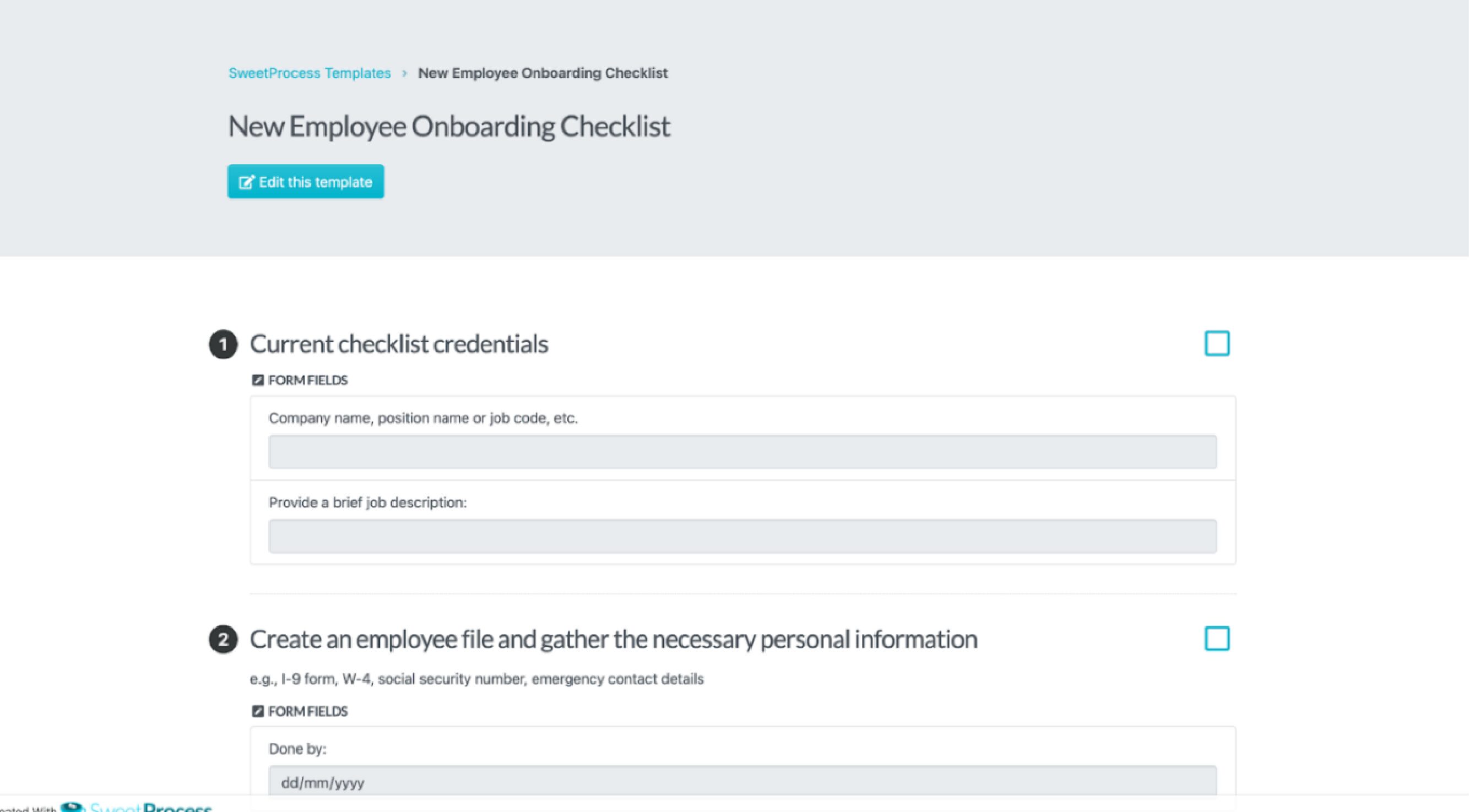
What does an employee onboarding checklist look like? Here’s a good example from SweetProcess that many organizations have used to successfully onboard their employees. This employee onboarding checklist template is customizable and allows you to edit it to your specific needs.
There are various items on the checklist:
- Title: Write the title of the checklist task for identification.
- Description: Summarize the task to give background information about the checklist.
- Steps: List each step of the task. These are individual activities arranged sequentially. There’s a provision for form fields to enter information about activities. There’s a box beside each step, which you can tick off once you complete the activity.
- Comments: Encourage team members to comment on the checklist if they need clarification.
- Series Tasks: Team members can view any subtasks created as part of the onboarding task.
- Task Activity: Track task progress by viewing how team members engage with the task in real time.
Employee Onboarding Examples You Can Learn From

What does employee onboarding look like in organizations? The onboarding process may be different for various businesses, but it’s all geared toward empowering employees to be efficient. For Emma Mills—owner and founder of MiPA, a virtual assistant company—signing off on documents is a major part of the onboarding process at her organization. It isn’t enough to educate and train employees on company activities; they must sign off documents as confirmation that they have understood its contents. Employees who struggle with understanding certain information or tasks can seek clarification before signing off the document. This gives the organization the confidence to assign signed-off tasks to employees.
“We onboard staff and team members quite regularly. The signing off, somebody signing their name to say, ‘Yeah, I’ve read this process. I understand it and approved it.’ It’s helped our training step up again to go, ‘Okay, well you know this person onboarded three weeks ago. We can see that they’ve fully understood and they’ve signed off that they’ve gone through these training modules,” Emma reveals.
It’s unrealistic to expect new employees to understand everything about an organization in the onboarding process. The goal is to familiarize them with activities in the organization and they become more knowledgeable over time. New employees are fond of asking more experienced staff questions on how to perform tasks. While it’s okay for established employees to help their new colleagues, doing that continuously makes them less productive because they have to abandon their tasks. To avoid that problem, Emma and her team adopted an employee onboarding software where they created a knowledge base containing all work-related information. When team members are unclear about anything, they can retrieve the information by themselves in the system without having to ask others.
“In our office where maybe a new team member will ask, ‘How do I do X?’ and I’ll hear Matt, my ops manager, say ‘Have you checked SweetProcess first?’ Most often, the answer is in there because it’s like this great collection. Before you ask any questions, just go in there and check. If it’s not in there, then we’ll write a process to cover it,” Emma says.
Jacob Syrytsia—chief executive officer at AEJuice, a video marketing company—adopts a similar onboarding process in his organization. He and his team document their business policies, procedures, and processes in a workflow management software which they use to onboard new employees. They promote self-learning by granting new hires access to relevant documents in the system.
“When somebody joins, I send them some links to SweetProcess and say just watch this, read this, and get back to me when you are ready. It’s like self-based training,” Jacob says. He finds that employees learn better this way due to less pressure.
Jacob understands that there’s only so much employees can learn during onboarding so he created a knowledge base for each department to facilitate continuous learning. He doesn’t stress himself when employees ask him questions on how to perform certain tasks—he simply sends them a link to documents containing information on how to perform the tasks.
“For every department, we have a separate knowledge base and there’s a manager for each department. Either the manager or I keep it up to date. Whenever someone asks ‘How do I use this tool?’ I just send them a link and it saves me about an hour of explaining,” Jabo explains.
There’s a common denominator in how both organizations conduct employee onboarding: They both streamline the process with a workflow management system, SweetProcess. From what they say, we can see that they are satisfied with its results. SweetProcess streamlines employee onboarding with several tools for continuous employee training.
Take advantage of those tools by signing up for a 14-day free trial without a credit card.
Onboard New Employees Seamlessly Using SweetProcess
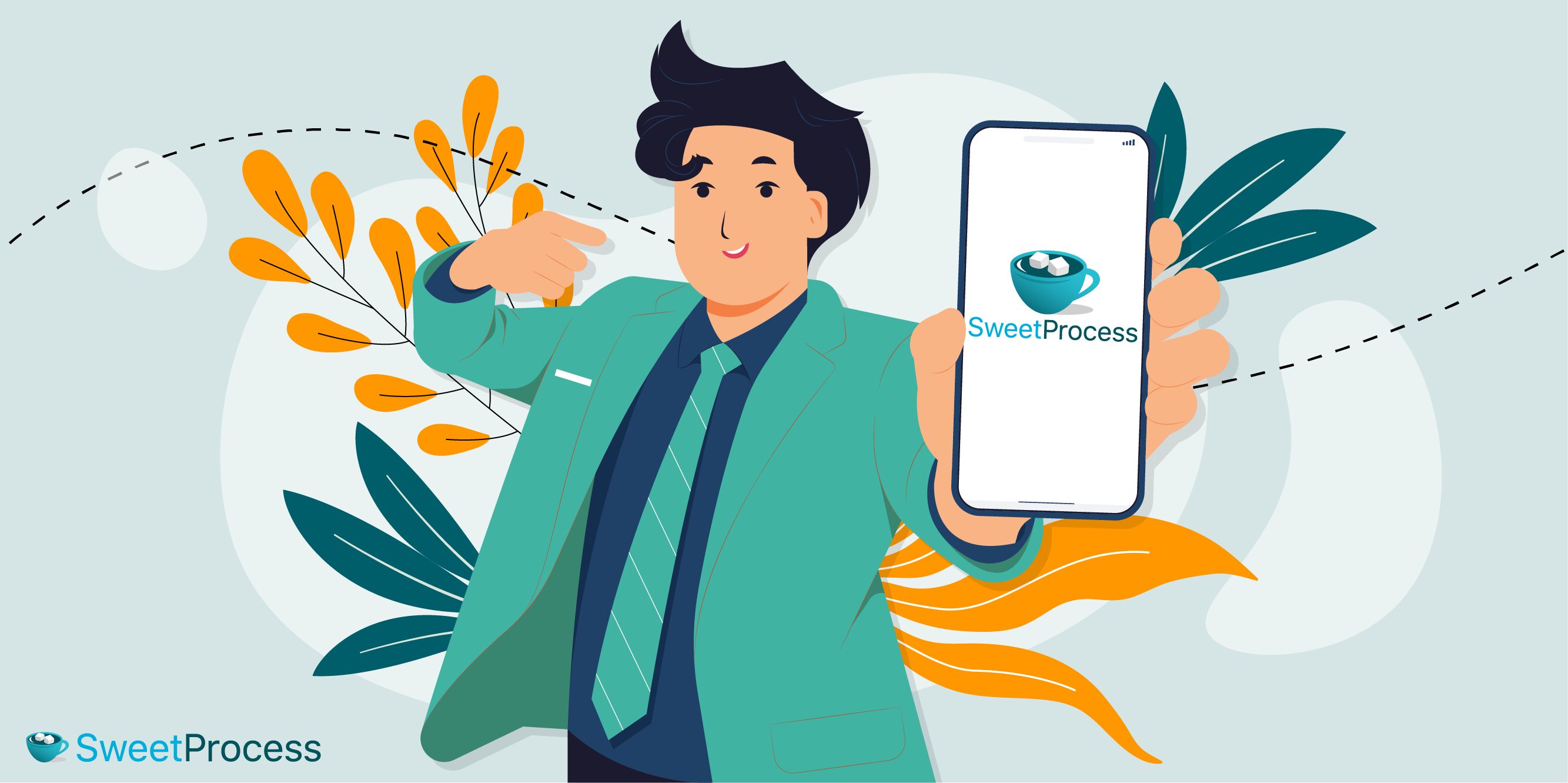
“I can now spend more time on bigger problems. SweetProcess frees your time,” Jacob says, describing SweetProcess as a game-changer in his organization.
Time is an integral factor in employee onboarding—you need to onboard staff quickly without jeopardizing the quality of their training. Longer onboarding doesn’t guarantee good performance, as you could spend several months onboarding new employees, but they end up making plenty of mistakes on the job.
How does Jacob make it work for him? He provides his employees with the information they need to perform their duties effectively during and after the onboarding process via a knowledge base in SweetProcess. Even if employees are clueless about something, all they need to do is look it up in the system. It’s a win-win for everyone: The employee is empowered to be efficient, the customer is satisfied with the services received, and the organization enjoys high returns.
Are you wondering if SweetProcess is a right fit for your business? You won’t know if you don’t try it. Sign up for a 14-day free trial without a credit card and decide if it’s worth it afterward.
